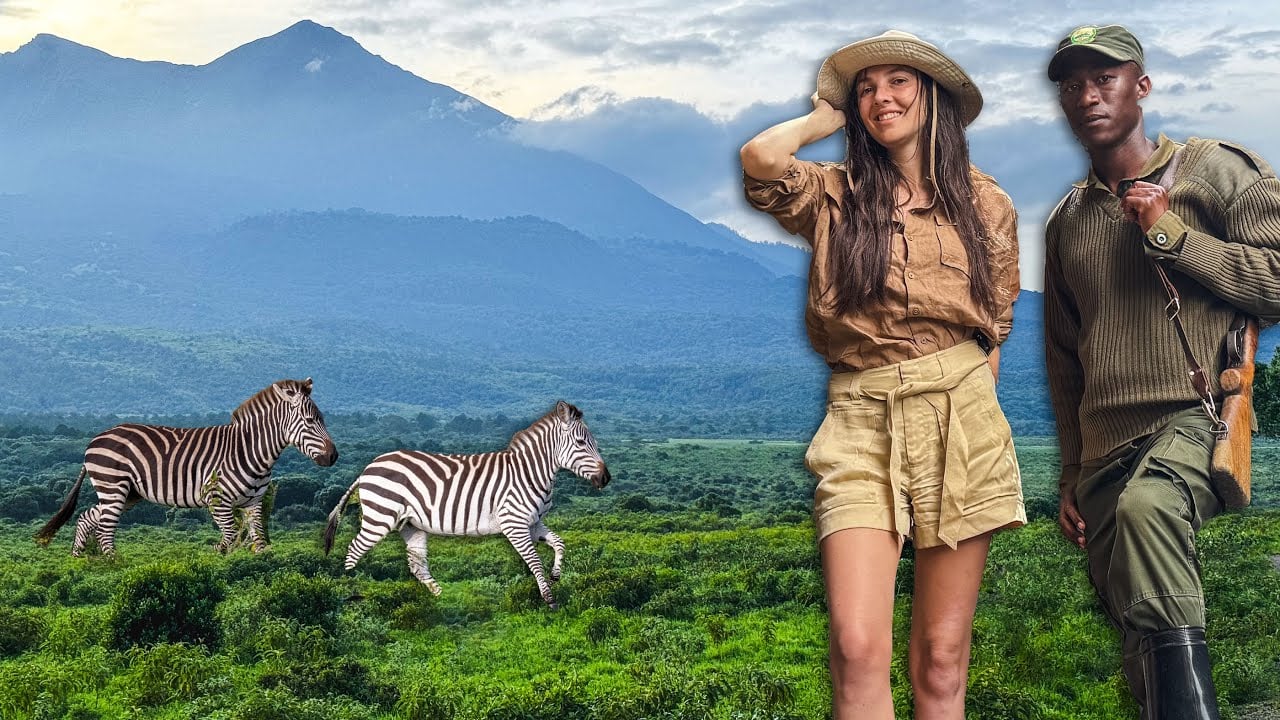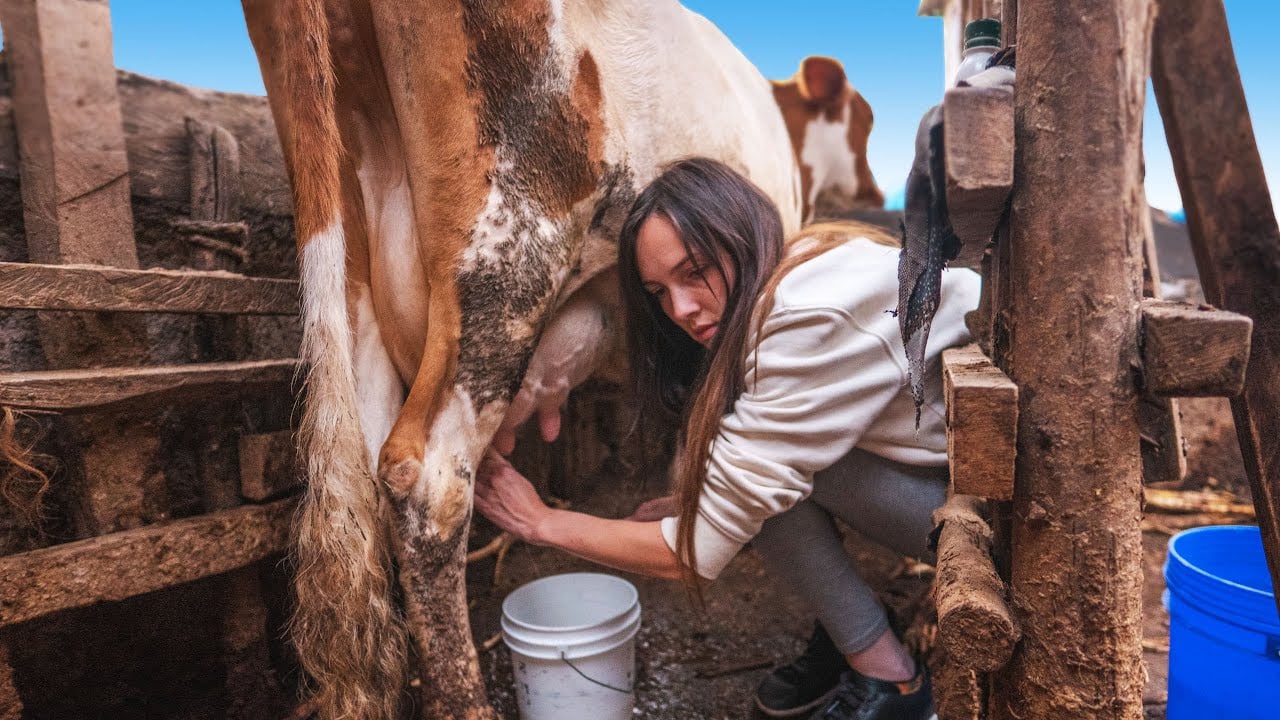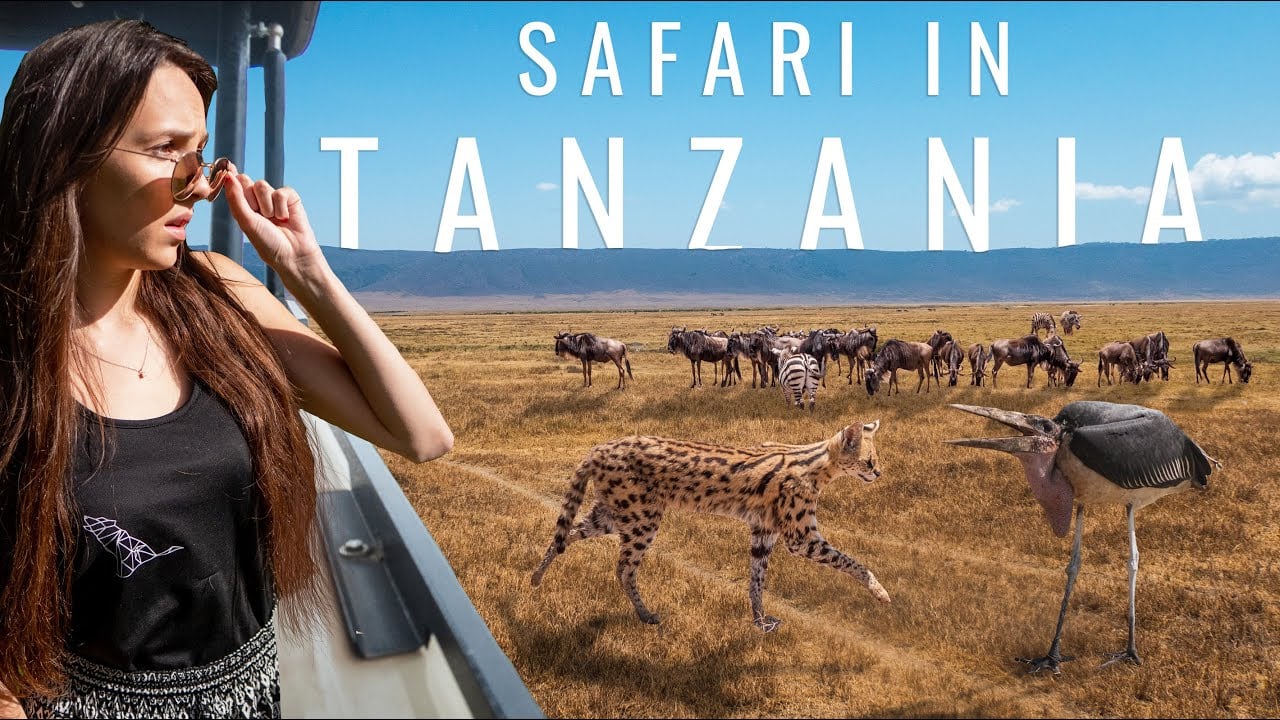One of Tanzania’s smallest parks, what Arusha National Park lacks in size, it sure makes up for in wildlife, unique activities, and outstanding natural beauty.
These are just a handful of the great reasons why I strongly believe Arusha National Park needs adding to your Tanzania itinerary!
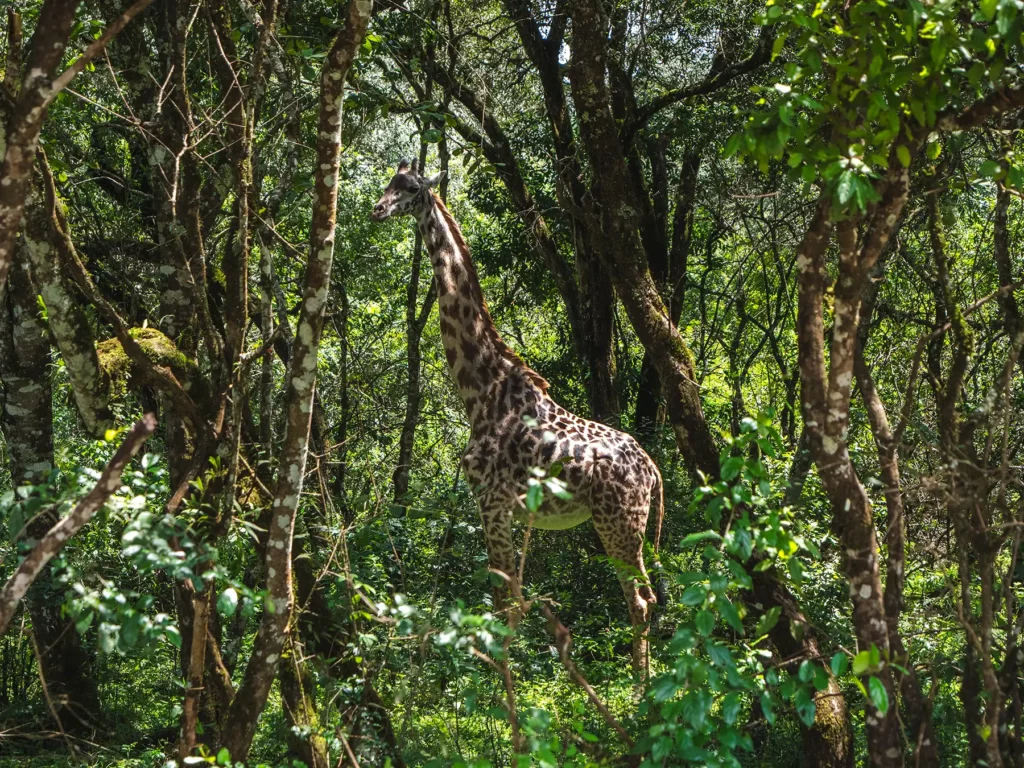
While most visitors to Tanzania skip Arusha National Park, I’m so glad I made time for it as it honestly far exceeded my expectations.
Arusha provides a completely different experience from other popular parks and still holds many iconic species, such as elephants, buffalos and giraffes. And the landscapes here, which are dominated by the epic Mount Meru, are breathtaking. A combination of lush jungles, towering waterfalls and alkaline lakes teeming with flamingos make Arusha incredibly special.
Arusha is one of the only national parks where you can experience the rush of a walking safari, spot the rare black and white Colobus monkeys, or push your limits and arrange a guided hike to the stunning Mount Meru summit.

I loved exploring this park on foot, gazing at the wildlife from beneath waterfalls and volcanic scenery – there’s no other safari experience quite like it!
Both Arusha National Park and the city are named after the Arusha people, an Indigenous group based on the western slopes of Mount Meru who migrated here from Kilimanjaro around 400 years ago.
In this definitive guide, I’ve shared everything you need to know about Arusha National Park so that you’re equipped to plan the perfect visit to Arusha.
Arusha National Park Map

Arusha National Park is divided into three, distinct districts: Mount Meru, Momella Lakes, and the Ngurdoto Crater.
Firstly is Mount Meru, a perfectly-shaped volcanic cone sporting a majestic crater that dominates the park. This spectacular mountain is located in the centre of the park, near the town of Arusha.
Next, as you head east of Mount Meru, you’ll find the Momella Lakes, a series of small, alkaline lakes that attract migrating water birds.
Finally, South of the Momella Lakes is the fascinating Ngurdoto Crater, also known as ‘little Ngorongoro’ thanks to its plethora of wildlife.
These three areas form a lopsided triangle that is just waiting to be explored!
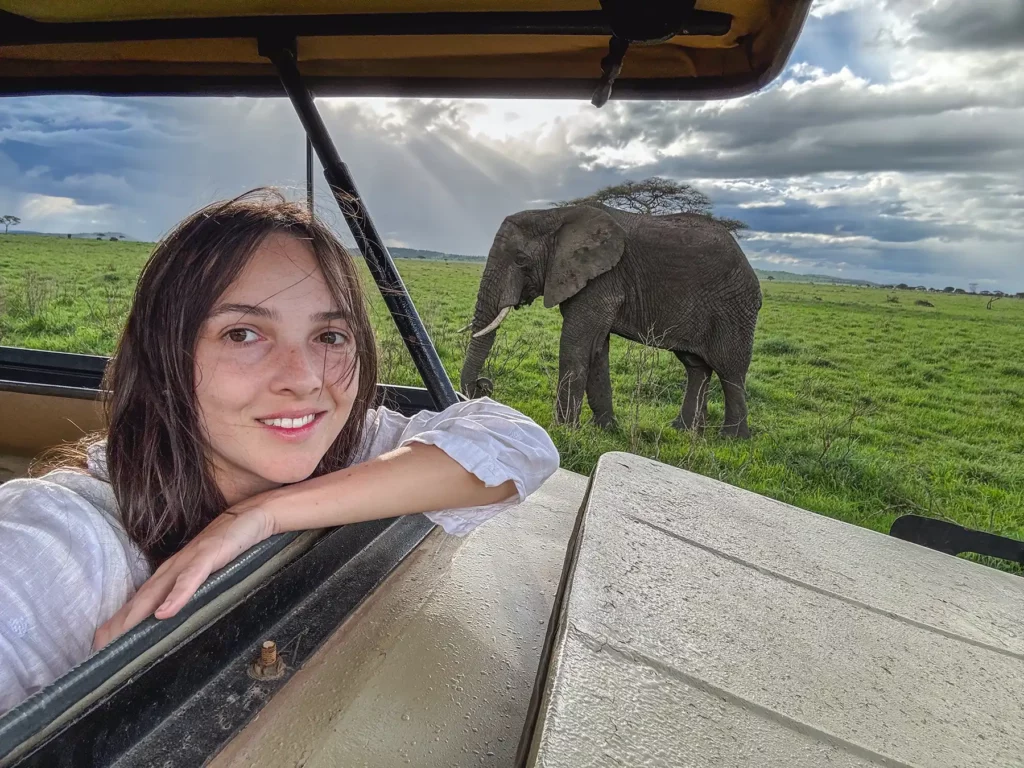
Embark on the Safari of Your Dreams
Save time and ensure an incredible safari experience by getting quotes from my recommended local safari companies
I’m here to make booking your perfect safari quick, easy and risk-free.
Join the rapidly growing tribe of over 1,000 travellers who’ve booked their dream safari using my insider tips and recommendations.

It takes under 60 seconds to fill out the form and in under 48 hours you will receive multiple, no-obligation proposals from my favourite local tour operators with glowing online reviews.
Get your free no-obligation safari quotes and my top safari tips and recommendations
In This Guide
- About Arusha National Park
- Wildlife in Arusha National Park
- Weather & Climate
- Best Time to Visit
- How Many Days
- Arusha National Park Safari Areas
- Safety
- Things to do
- How to Book your Arusha NP Safari
- How Much Does a Arusha National Park Safari Cost?
- Is a Arusha National Park Safari Worth it?
- Accommodation – Where to Stay
- Getting to Arusha National Park
- How Does Arusha NP Compare?
- Best Arusha National Park Safari Itineraries
- 5 Facts About Arusha National Park
- Arusha National Park Safari Videos
- Read More Tanzania Guides

About Arusha National Park
Arusha National Park is part of Tanzania’s ‘North Circuit’ safari route. This route consists of various national parks, game reserves, conservation areas, and private concessions, including the world-famous Serengeti National Park and Ngorongoro Crater, alongside Tarangire National Park and Lake Manyara National Park. The close proximity of these parks mean it’s extremely easy to visit them all as part of a 2-week or 7-10 Day Tanzania safari itinerary.
In What Country is Arusha National Park?
Arusha National Park is located in the East African country of Tanzania. Situated near the border of Kenya in Tanzania’s northeast corner, the park is less than an hour’s drive from Arusha, one of Tanzania’s most popular cities and tourist destinations.
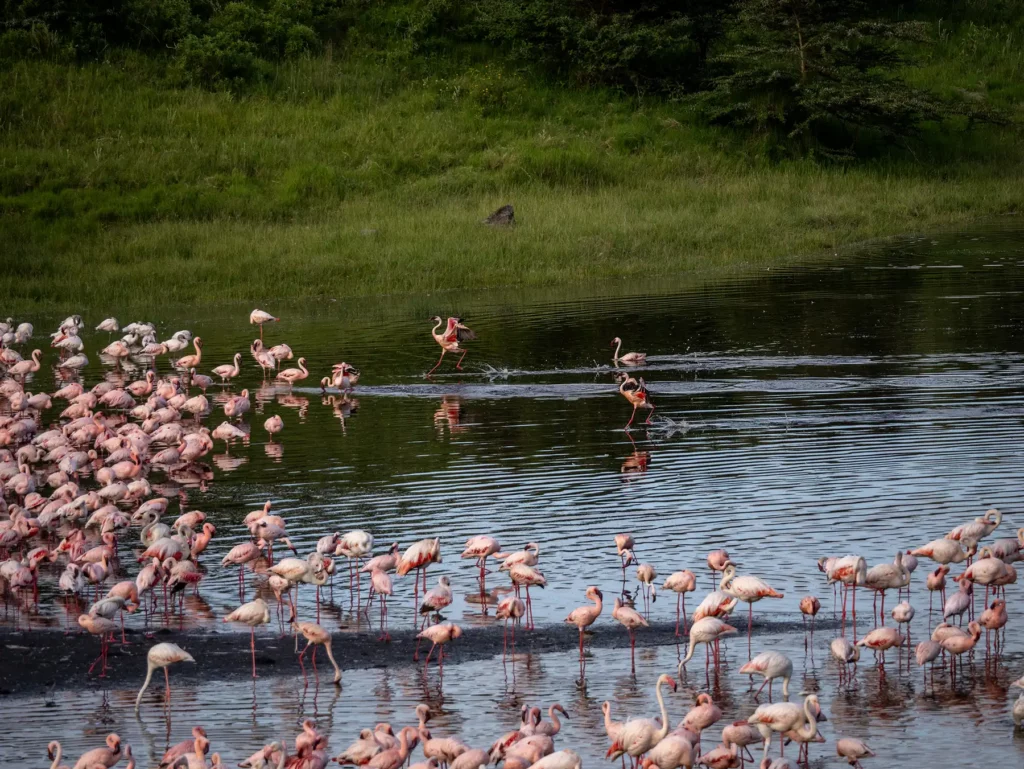
How Big is Arusha National Park?
I’m sure you’ve heard the saying that good things come in small packages. Well, this couldn’t be more accurate when describing Arusha National Park.
This pint-size park is just 53 miles² (137 km²). To put this into comparison, the Masai Mara National Park in Kenya stretches an impressive 583 miles² (1,510 km²), Serengeti National Park measures 5,700 miles² (14,763 km²), and Kruger National Park in South Africa comes in at an extraordinary 7,523 miles² (19,485 km²).
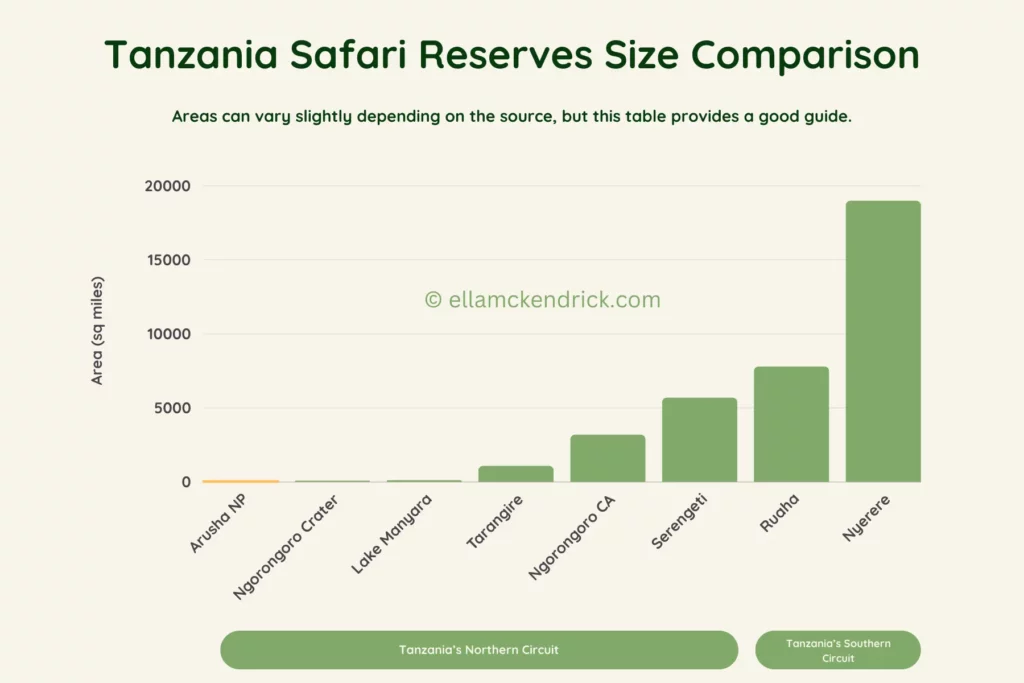
Despite its small stature, Arusha National Park packs in a pretty big punch, offering intrepid travels spectacular scenery, fascinating wildlife, and a slew of activities. Plus, it’s extremely easy to access from the nearby city of Arusha and the Kilimanjaro International Airport. This makes it an excellent addition to Northern Circuit itineraries.
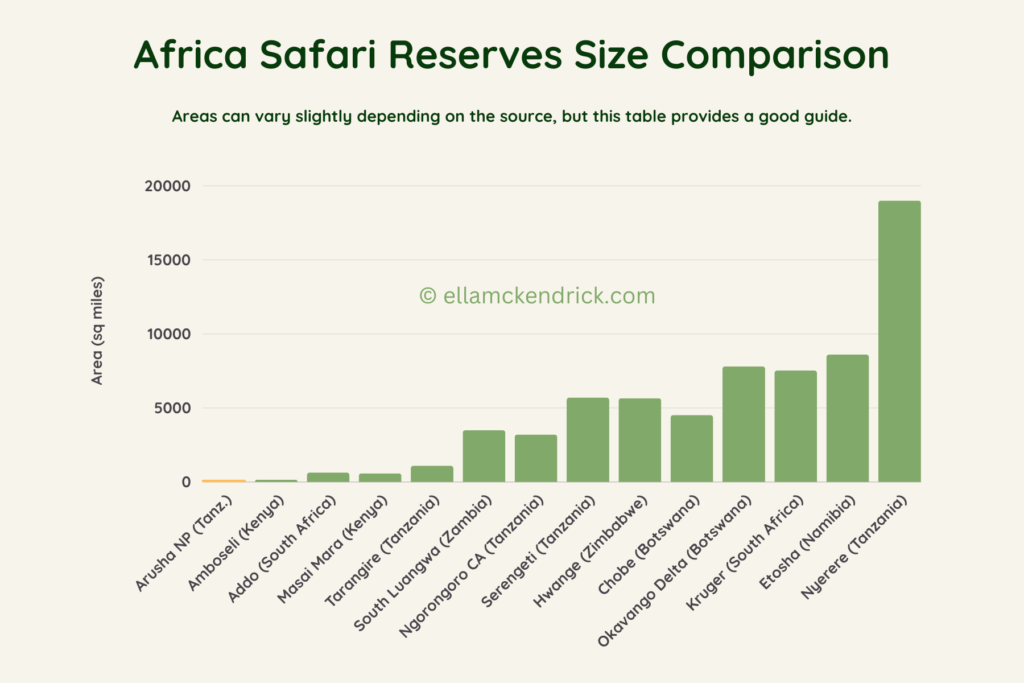
What is So Special About Arusha National Park?
As one of Tanzania’s most accessible national parks, Arusha National Park offers visitors the chance to see some incredible wildlife without having to venture too far off the beaten path. This makes it a great destination for visitors who are short on time but still want to get a small taste of what Tanzania has to offer.

But what makes the park feel really distinctive is the juxtaposition between the bustling city of Arusha and the untouched natural beauty of the park. Driving away from the city traffic and into the park feels almost like you’re entering a parallel universe, and there’s something truly powerful about the proximity of human and animal habitats.

Gone is the noise and traffic of the city, and into Arusha’s breathtaking scenery. Mount Meru looms above you while the Momella Lakes glisten in the distance. In the nearby swamplands, herbivores of all shapes and sizes can be seen lazily grazing, from herds of buffalos to elegant giraffes, families of warthogs to zebras.
Arusha’s diverse landscapes attract a rich array of birds and mammals, some of which are found nowhere else in Tanzania. The park is home to both Colobus and Blue Monkeys; in fact, this is one of the best places in Africa to spot these rare primates!
Best of all? Arusha offers walking safaris that allow you to get a close-up look at these, and many other, animals. This is one of the few national parks in East Africa where you can enjoy a walking safari so definitely jump on the opportunity – this makes visiting Arusha a unique experience!
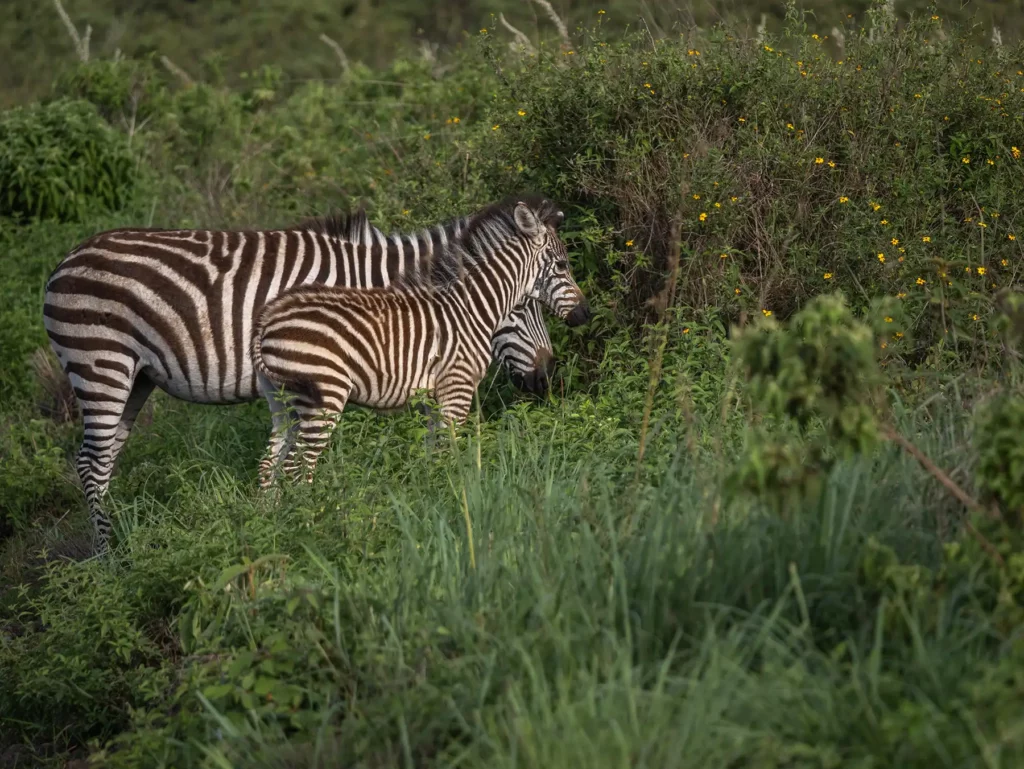
Black-and-White Colobus Monkeys in Arusha National Park
The chance to view black-and-white colobus monkeys is one of the highlights of a trip to Arusha National Park. There are at least six different species of colobus monkeys located around the world, but black-and-white colobuses are found only in equatorial Africa.
These unique primates are famous for their luxurious tuxedo-like coats, complete with thick white beards and fluffy tails. Interestingly, the word ‘colobus’ comes from the Greek word ‘mutilated,’ due to the fact that colobus monkeys don’t have any thumbs.

Although black-and-white colobus monkeys spend most of their time high up in the trees, they are hunted by both animals and humans. They serve as prey for leopards and chimpanzees, while for humans they were once hunted excessively for their beautiful fur. While conservation efforts have allowed their populations to rebuild, the animals are still at risk due to habitat loss as forests are cut down to allow more space for agriculture, housing, and roads.
When visiting the park, keep in mind that they spend more time up in the trees than any other primates. This makes it tricky to get decent photos of them, which you can clearly see by taking a look at my photos of little more than their fluffy tails! I have found that it’s sometimes best just to put my camera down and simply enjoy their acrobatic antics as they crash through the canopy above me.
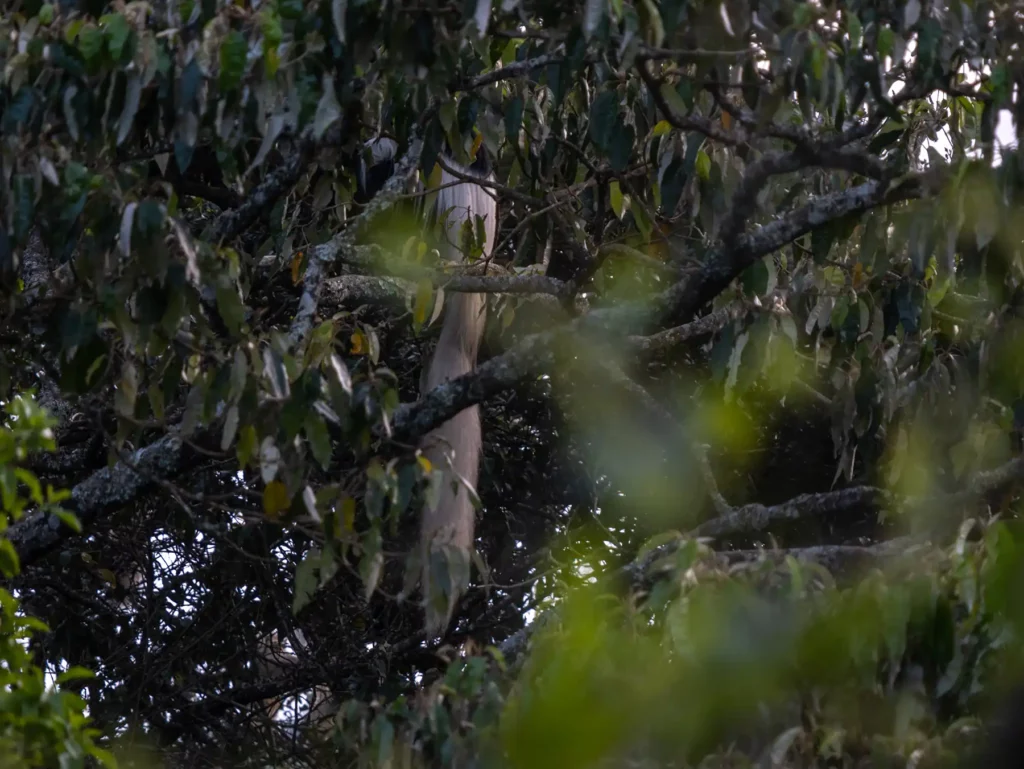
Mount Meru
At the heart of Arusha National Park is the epic Mount Meru, a massive stratovolcano standing at an impressive 4,566 metres. Meru is the second-highest mountain in Tanzania, after Mount Kilimanjaro, and the fifth-highest mountain in Africa.
Located just 43 miles (70 km) from Mount Kilimanjaro, it is believed that Meru was once the highest mountain in Africa. However, Mount Meru experienced a major eruption millions of years ago that blew the top off of the volcano. What was left of its summit then collapsed around 7,800 years ago, giving it a distinctive horseshoe shape. While it’s still considered an active volcano, its last minor eruption occurred way back in 1910.
Today, Mount Meru is a popular place for hiking. Due to its dominating height, it provides a great acclimatisation climb for anyone hoping to tackle Kilimanjaro. It’s also a great alternative for anyone hoping to get a bird’s eye view of the savannah without climbing Kili itself.
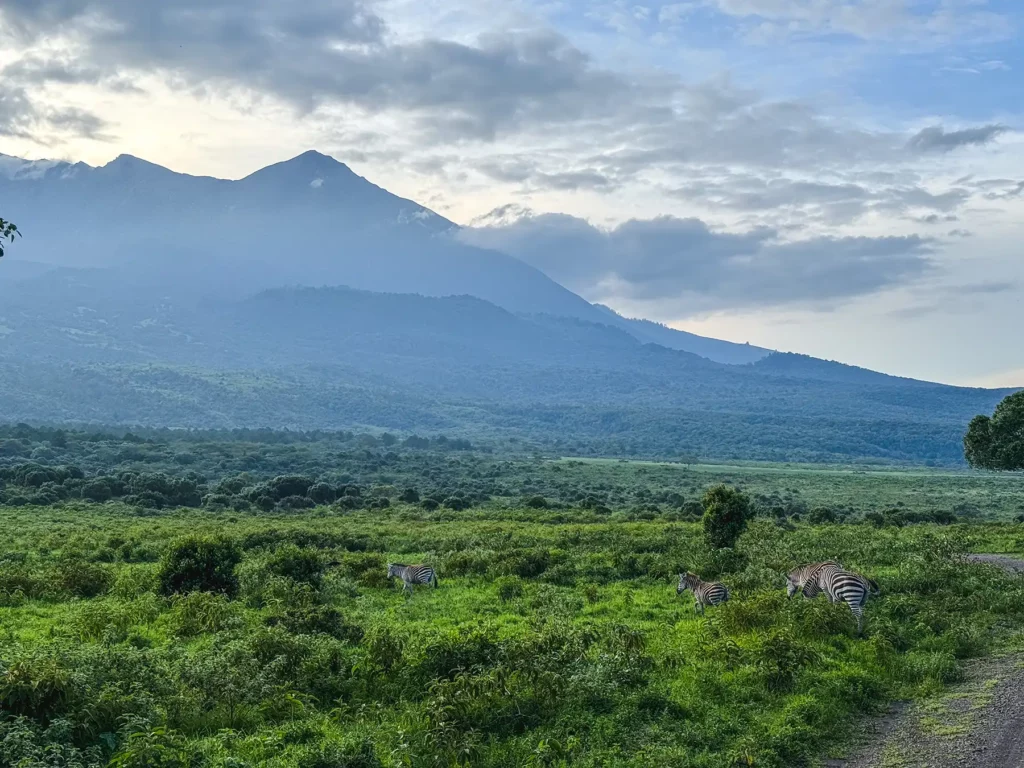
The Momella Lakes in Arusha National Park
The Momella Lakes are a group of seven shallow alkaline lakes within Arusha National Park. As the lakes get their water from rainfall and underground streams, they all have different algae and mineral compositions, resulting in an incredible array of wildlife.
Although no animals can drink from the Momella Lakes due to their high alkaline content, they are a wonderful spot for wildlife spotting. Visitors can hope to see hippos, zebras, and water birds, including vast flocks of flamingos.
While many game drives visit areas around the lakes, one of the best ways to explore the Momella Lakes is on a canoe safari. These water-based safaris let you get a close-up view of the lakes and their inhabitants as you slowly bob up and down in the calm water.
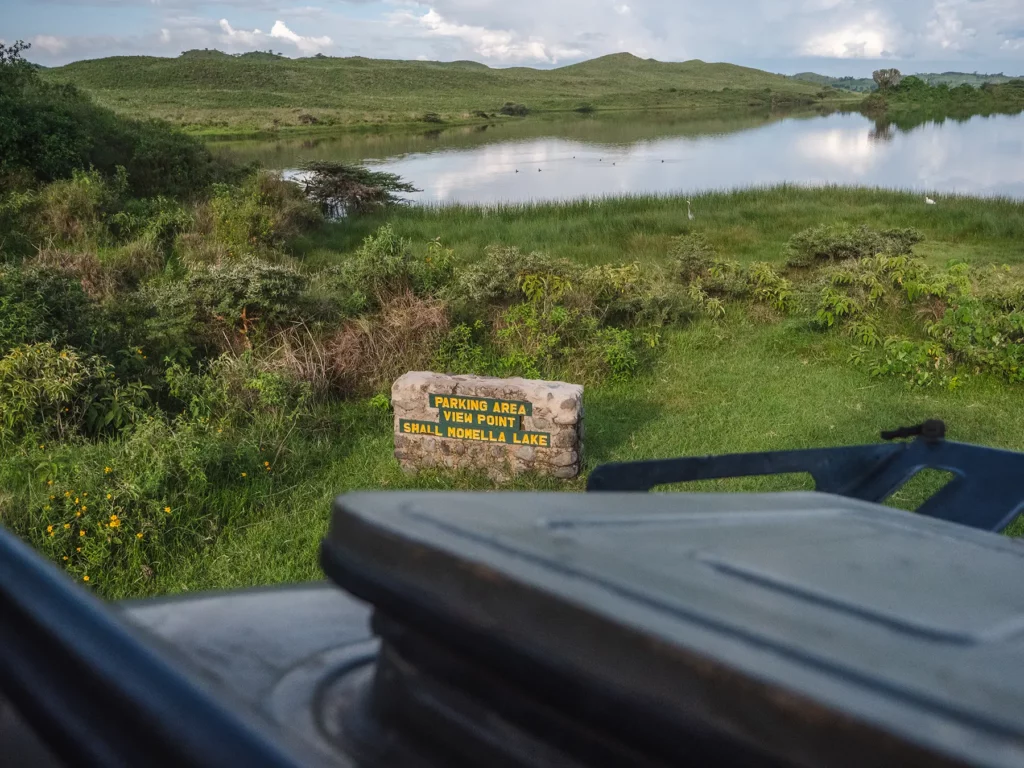
History of Arusha National Park
The area that makes up Arusha National Park and its surroundings has been formed over the course of millions of years and, in many ways, it’s still under construction today.
Much of the landscape was created around twenty million years ago, around the same time as the Great Rift Valley (Earth’s largest continuous valley) when tectonic plates started to move apart. Flash forward many, many years and Momella Lakes were formed around when Mount Meru erupted around 250,000 years ago. Around 7,800 years ago, Mount Meru’s summit collapsed and much of its impressive height was lost.
In more recent history, the settlement of Arusha was established by a tribe of farmers and pastoralists who migrated there from Kenya in the late 18th century and early 19th century. These immigrants are considered to be distinct from but related to the Maasai. Known as the Arusha, these tribes kept a similar social structure to their counterparts and often participated in battles around Mount Kilimanjaro.
Meanwhile, the European history of the modern-day park can be dated back to 1876 when a Hungarian count visited the area and commented on the vast number of hippos and black rhinos that he saw there. Shortly after, German settlers arrived and defeated the Arusha people. By the end of the century, Tanzania was part of German East Africa.
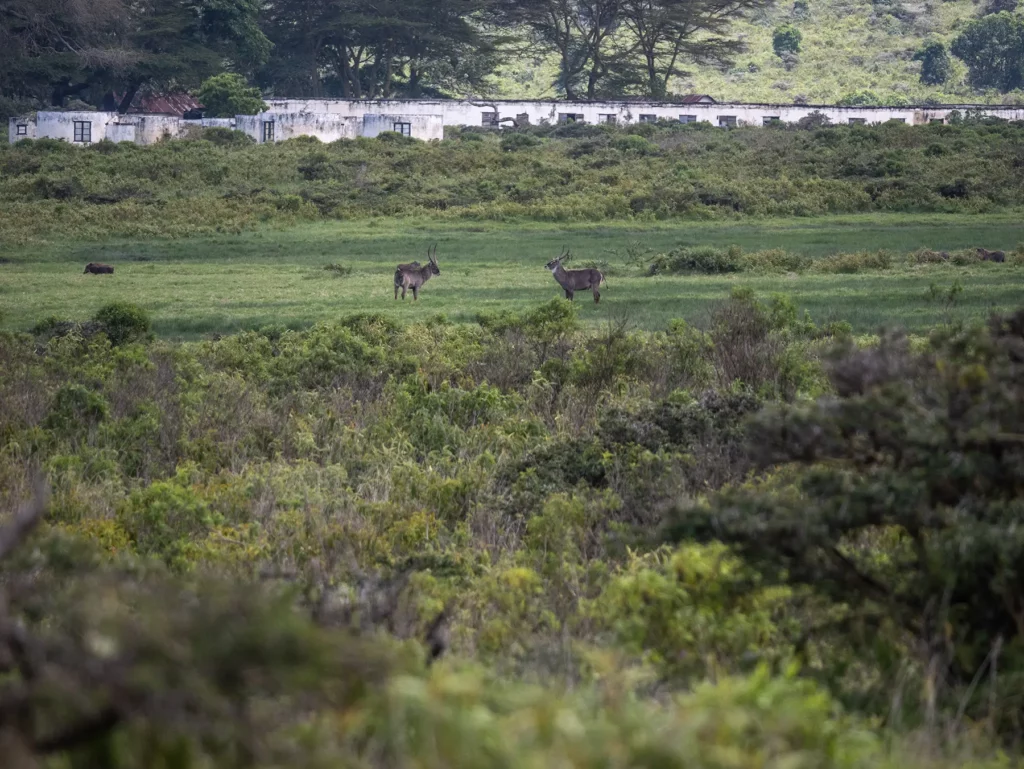
The land surrounding Arusha was then divided up between German and Afrikaner immigrants and in 1907, the Trappe family moved to Momella. These German settlers began using the present park as a cattle ranch and this is when conservation efforts began to be put in place to protect the beautiful, yet fragile, landscape. Mrs Trappe later donated a huge part of the estate to be used as a game sanctuary.
By 1960, the area was declared Ngurdoto Crater National Park and the old Momella farm was incorporated into this new national park. In 1967, Mount Meru was annexed and the name was officially changed to Arusha National Park.
Today, Arusha National Park is managed by Tanzania National Parks (TANAPA) which was formed as a result of the 1959 Tanganyika National Parks Ordinance.
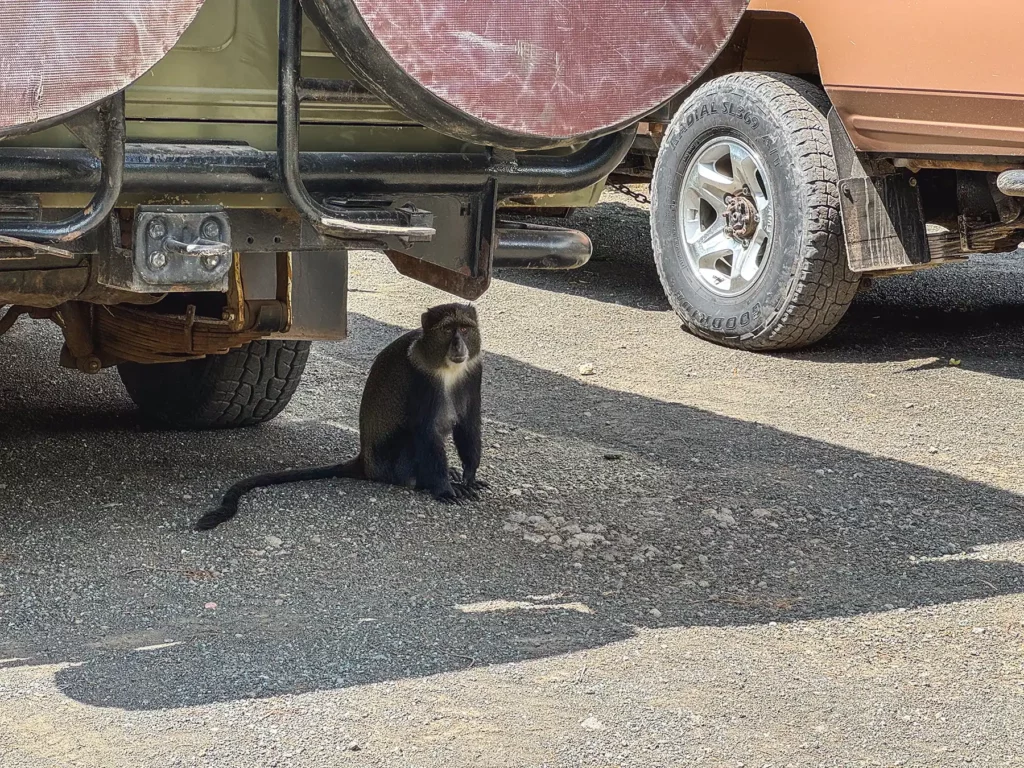
Animals in Arusha National Park
Arusha National Park boasts Tanzania’s largest population of giraffes. It’s also home to buffaloes, warthogs, zebras, elephants, leopards, bushbucks, hippos, and assorted primates. In addition, the park has a stunning array of bird species, such as flamingos, grey-crowned cranes, and the African fish eagle.

What is the Main Animal of Arusha National Park?
Arusha National Park is home to the world’s largest population of giraffes. According to the Giraffe Conservation Federation, there are 462 living in Arusha National Park, which gives it a population density of roughly 3.5 giraffes per square kilometre!
Due to the park’s mountainous terrain, it’s easy to see giraffes as they lumber through the park. Trust me, there’s nothing quite like seeing the elegant neck of a giraffe poking up through a thick forest. Especially if there are dozens of them!
The park is also known for its large gatherings of flamingos. Depending on the time of year you visit, you may see hundreds at Momella Lakes. The best time to see the flamingos is during the dry season (between June and October) when they tend to congregate in large numbers.

What are the Rarest Animals in Arusha National Park?
Some of the rarest animals in Arusha National Park include leopards, and red duikers. Although the park boasts healthy populations of these animals, the dense foliage and their elusive nature can make them difficult to spot.
Cheetahs and elephants are also quite rare to see here.
It may be surprising to learn that cheetahs can be found in Arusha as they prefer open savannah as opposed to forest. However, cheetah sightings do occur from time to time.
Elephants, whilst frequently spotted in Tanzania’s other parks like Serengeti and Tarangire, are rare here. There are less than 200 individuals within the park and they are seldom seen.

Can I see the Big Five in Arusha National Park?
There are no lions or rhinos in Arusha National Park, so it’s not possible to see the Big Five during your visit.
The last confirmed lion sighting in the park was in 1998. This absence is primarily due to the park’s proximity to densely populated human areas
With elephants and leopards being hard to spot, buffalo are the only animals out of the Big Five that are regularly seen in Arusha National Park.
There are other parks in Tanzania with lions and you can see the relative density of lions in the chart below.
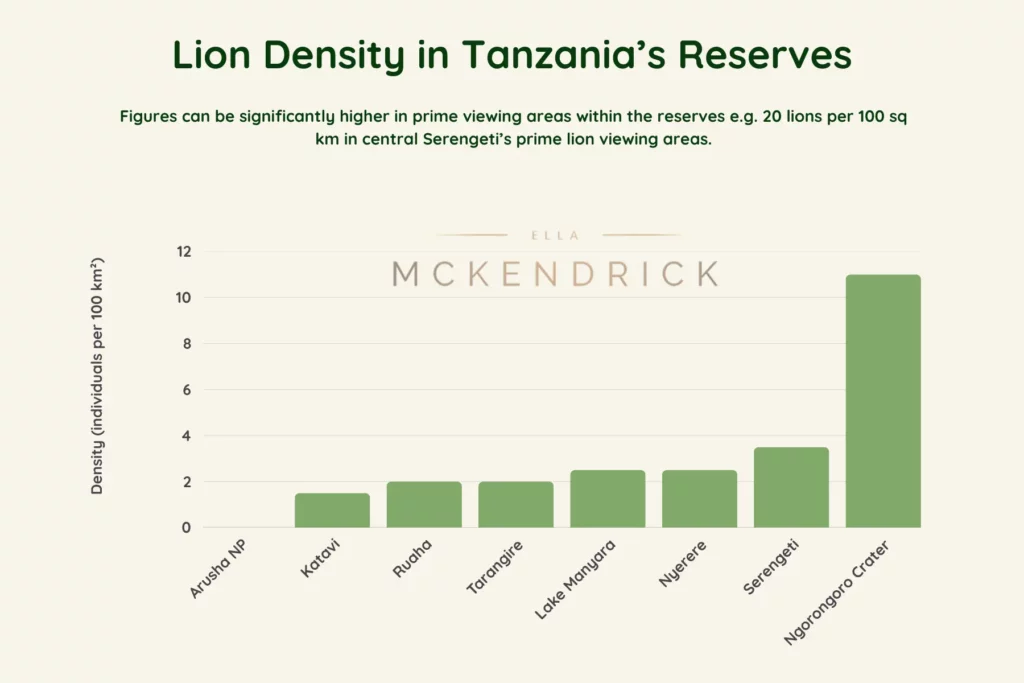
Despite the lack of lions, Arusha is still worth visiting. There are many other incredible species here, ranging from the diminutive dik-dik to the lofty giraffe. And Arusha is worth visiting for more than wildlife spotting; it’s equally well-regarded for its beautiful scenery.

Is Arusha National Park Good for Birdwatching?
Arusha National Park is a fantastic place for birdwatching due to the famous Momella Lakes.
More than 400 species of birds can be found here, including lesser and greater flamingos, malachite kingfishers, African fish eagles, Abyssinian nightjars, grey-crowned cranes, African jacanas, collared palm thrush, brown woodland warbler, among many, many more.
As most of the park’s bird species congregate at the lakes, the best way to view them is via a canoe safari.
The best time to see birds in Arusha and the whole of Tanzania is between November and April when the landscape is lush and rainfall is more common. This is when the birds breed and have bright plumage.
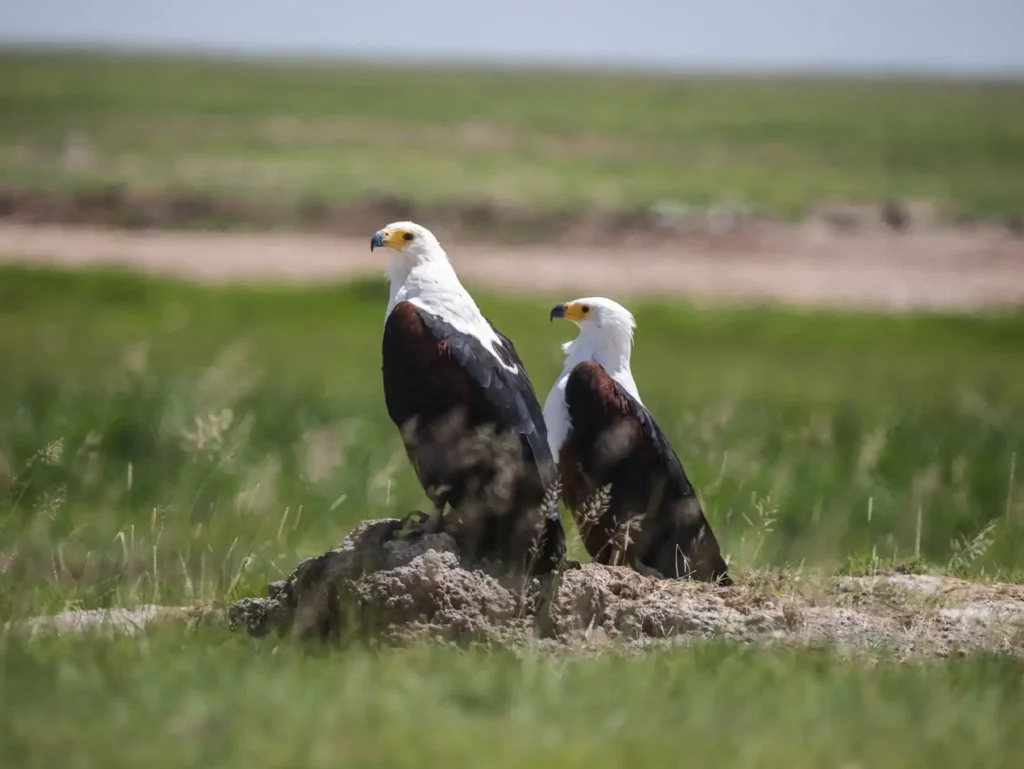
Wildlife Conservation in Arusha National Park
Like much of Africa, the area surrounding Arusha National Park suffered dearly during the heyday of poaching.
Fortunately, the days of mass hunting seem to be gone and wildlife conservation has been a major focal point at Arusha National Park for over a century. Since the area officially became a national park in 1960, the park authorities have created anti-poaching patrols, restored and protected black and white colobus monkey populations, and reintroduced giraffes back into the park.
To prevent future degradation of the environment, Arusha National Park works to promote education, economic development, and sustainable tourism in local communities, while preventing deforestation and unsustainable agricultural practices.
The park has also set up vigorous projects to research and monitor the park’s flora and fauna and to restore the destroyed habitats.
What are the Threats to Arusha National Park?
While Arusha National Park doesn’t face the same outside threats as other parks, such as poaching and big game hunting, ecologists are concerned about inbreeding due to the park’s limited gene pool. As long-established wildlife corridors are blocked and shrunken, local animals are no longer able to exchange with those in other areas.
The encroaching human settlements are also increasing the likelihood of poaching within the park as it becomes more accessible.
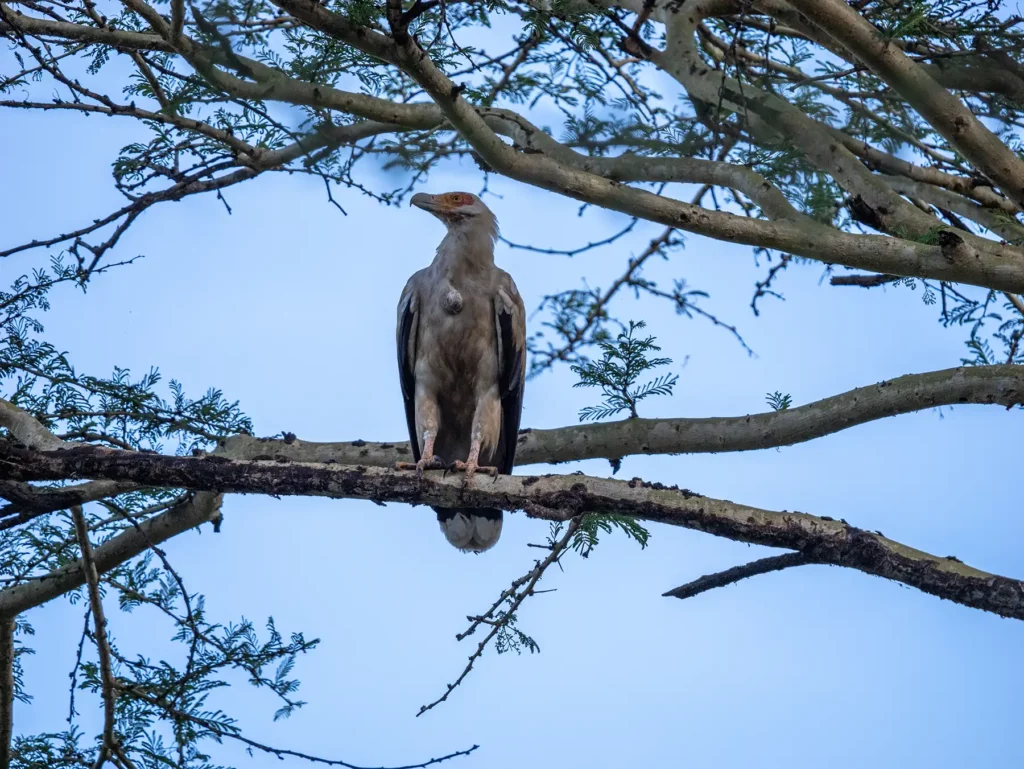

Embark on the Safari of Your Dreams
Save time and ensure an incredible safari experience by getting quotes from my recommended local safari companies
I’m here to make booking your perfect safari quick, easy and risk-free.
Join the rapidly growing tribe of over 1,000 travellers who’ve booked their dream safari using my insider tips and recommendations.

It takes under 60 seconds to fill out the form and in under 48 hours you will receive multiple, no-obligation proposals from my favourite local tour operators with glowing online reviews.
Get your free no-obligation safari quotes and my top safari tips and recommendations
Weather & Climate Arusha National Park
Although many East African national parks can get scorching hot, Arusha National Park has a very mild climate due to its higher altitude. The dry season lasts from June to September while the rainy seasons run from March to May and then again from November to December.
During the dry season, the temperature usually hovers around a very pleasant 19 degrees Celsius (66 degrees Fahrenheit) and you can expect lots of clear skies and sunny weather. At night, the temperature drops to around 9 degrees Celsius (48 degrees Fahrenheit), which, in my humble opinion, is the perfect weather to snuggle up under a cosy blanket as you drift off to sleep!
It gets a bit warmer during the rainy season when the temperature reaches around 23 degrees Celsius (73 degrees Fahrenheit) during the day and around 11 degrees Celsius (52 degrees Fahrenheit) at night.
November and December normally have short rains in the middle of the afternoon. March to May are the wettest months and it’s likely to rain every day. Don’t give up in defeat if this is the only time that you can visit the park; it rarely rains all day long and the weather patterns often bring unique animals with them!
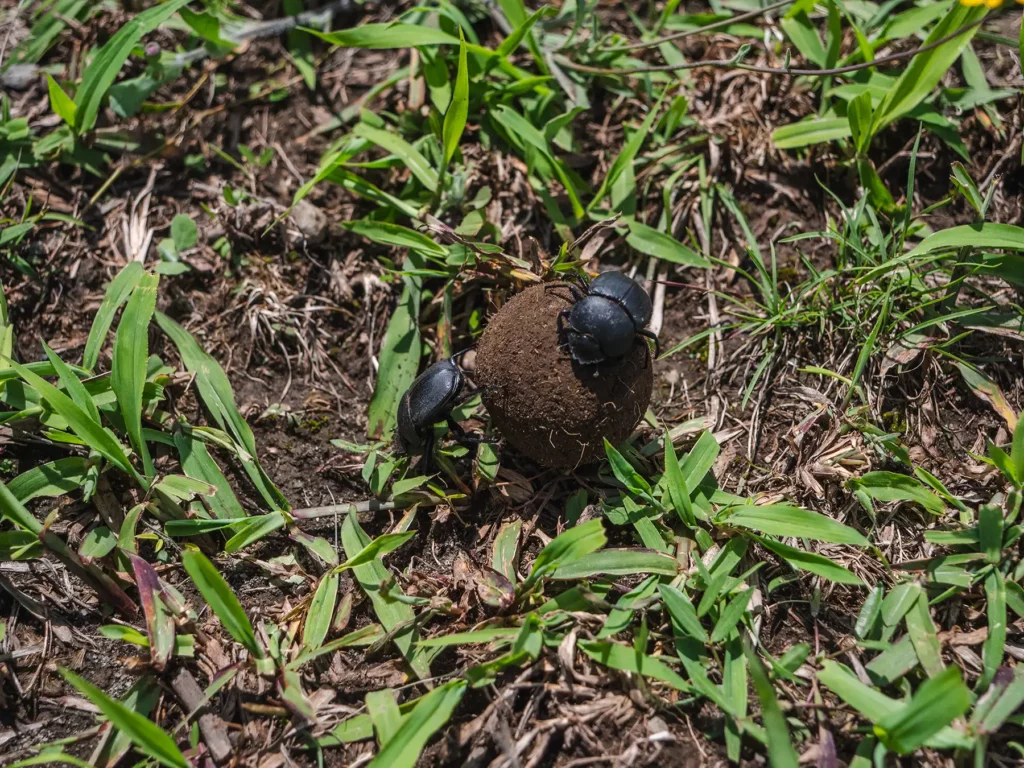
What is the Best Time / Month to Visit Arusha National Park?
As with most reserves in Tanzania, the best time to visit Arusha National Park is during the long dry season between June and September.
Below I’ve ranked each month in Arusha National Park.
- Excellent
- Good
- OK
- Poor
Below, I’ll take you through each of the main seasons. I have also added some seasonal information for the surrounding parks, so if you’re planning to visit a few, this will help you plan accordingly.
January and February are known as the short dry season when you’ll find wildebeests calving and migrating in the southern tip of nearby Serengeti National Park. You’re also more likely to see large herbivores in Arusha National Park as they come out of the forests searching for water. Another pro is that you’ll also find below-average rates for accommodation as this time of year isn’t as busy as the long dry season.
March through May sees long rains. Towards the end of the spring, wildebeests begin their crossing of the Grumeti River in the Serengeti. Prices for accommodations, safaris, rental cars, and flights tend to be at their lowest. However, the strength of the rains at this time of year mean that there’s a heightened risk of flooding and many roads become inaccessible. I personally wouldn’t recommend visiting at this time of year as the floods can be devastating.
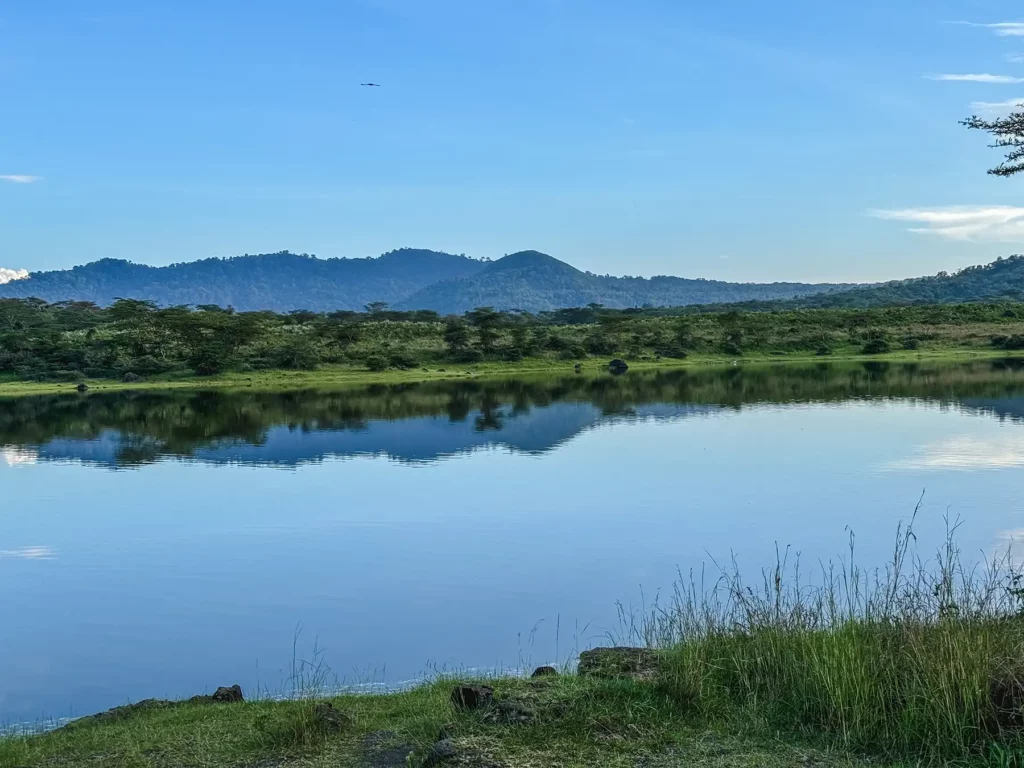
The peak tourism season lasts from June until mid-October when visitors flock to northern Tanzania to watch the Great Wildebeest Migration as the wildebeest cross the crocodile-infested Mara River. Also known as the long dry season, this is the best time to see all kinds of wildlife as the foliage has died back, making them easier to spot, and the lack of rain makes animals congregate around water sources. However, expect to find prices skyrocketing and high numbers of visitors in all of the parks. I still think this is a great time to go, particularly in September when the crowds are slightly less.
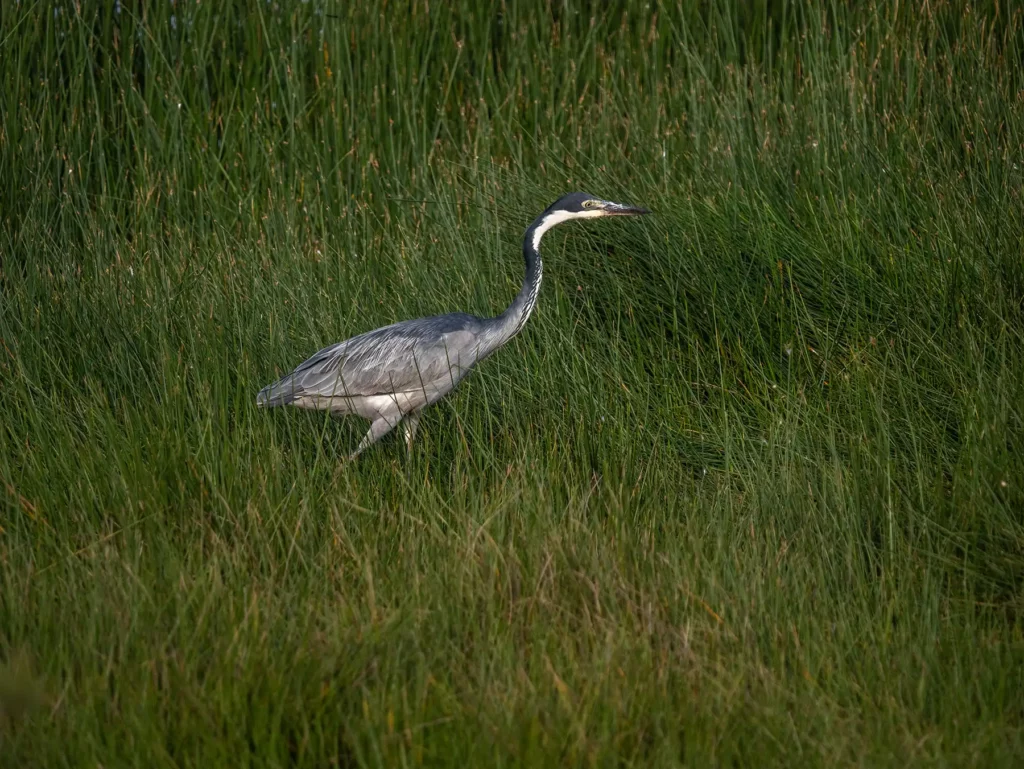
Things begin to slow back down in the second half of November as the short rains begin. The wildebeests cross back over the Mara River in the Serengeti and the birthing season begins for many different animals. This is one of the best times to see big cats stalk their prey.
The tail end of December sees the return of many migratory birds which makes it the perfect time for birdwatching at Momella Lakes.
I’ve ranked each month of the year for safari in Tanzania as Excellent, Good, OK, or Poor, based on typical game viewing and weather conditions.
If you want to dig deeper, the chart below shows what you can expect in each month in Tanzania in terms of cost, weather, wildlife and hiking Kilimanjaro.

For more information take a look at my ultimate guide on the Best Time to Visit Tanzania.
Is Arusha National Park Crowded?
As with all of the Northern Circuit parks, the busiest time of the year is during the dry season. However, Arusha National Park seldom gets crowded even during the peak of the dry season. This is because Arusha National Park is often overlooked, largely because it doesn’t have the entirety of the Big Five.
Therefore, unlike many of the other national parks, you’re unlikely to find yourself surrounded by safari vehicles as hundreds of visitors take photos of the same few animals. I think this is a huge draw to Arusha National Park as it makes the experience feel extra magical and relaxing.
How Many Days Should I Spend in Arusha National Park?
Since Arusha National Park is very easily accessible from the city of Arusha and is pretty small in size, it’s easy to see the main attractions and even squeeze in a few activities within a day.
You can even see much of the park within a half day if you’re pressed for time (for example, if you’re only staying in Arusha for one night before or after a flight). However, this may feel a little too rushed for most people and so I’d recommend allocating one full day to exploring the park.
If you are planning on climbing Mount Meru, allow for an additional three to four days.
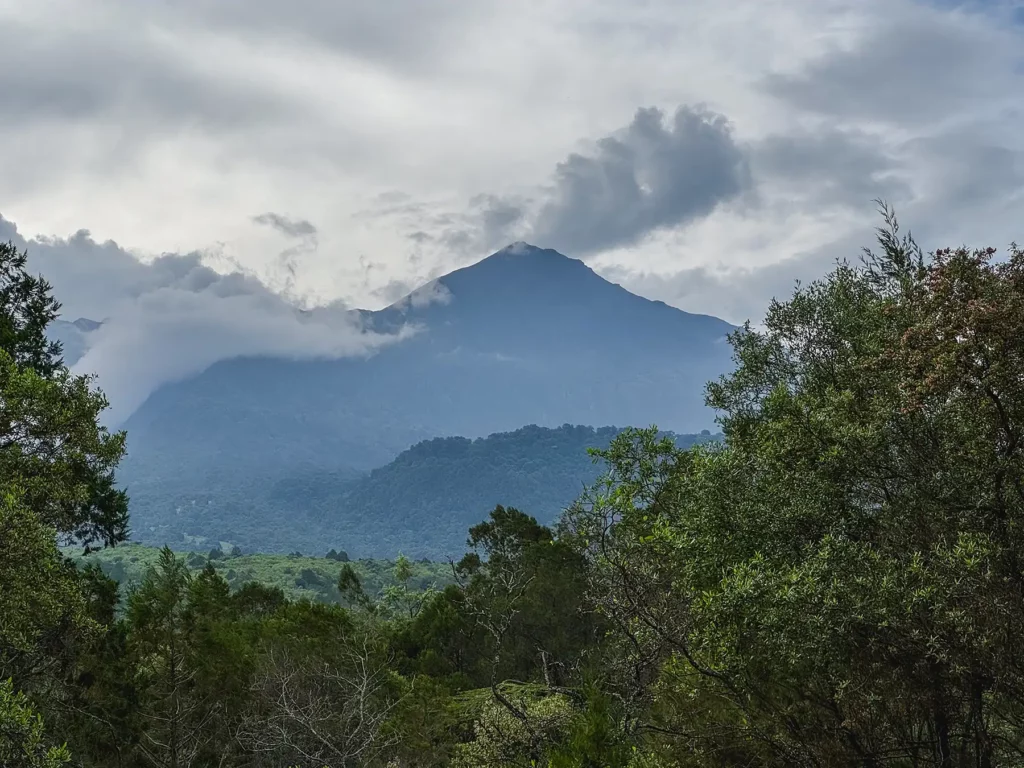
Arusha National Park Safari Areas
Arusha National Park is divided into three distinct sections, each of which offers a very different safari experience. I have broken these areas down below to help you plan your trip to the park and prioritise what you want to see first!

You can jump to each of the areas using the links below.
Little Serengeti
Little Serengeti is located just west of the Ngurdoto Crater, not far from the southern entrance to the park. Also known as Serengeti Ndogo, this small savannah area is the only place in Arusha National Park where you can spot plains zebras. You can also find giraffes, buffalo, and other large herbivores here.

Little Ngorongoro Crater (Ngurdoto Crater)
Ngurdoto Crater is tucked away in the southeastern corner of Arusha National Park. The crater has a diameter of 2 miles (3.2 km) and is roughly 300 metres deep. Although the volcano that created this caldera is long gone, it left behind an evergreen swamp and thick forests surrounded by steep, rocky cliffs. It is teeming with wildlife, causing many people to nickname it the Little Ngorongoro Crater.
The floor of the crater is very soft which makes it impossible to do game drives within the crater like you can in other areas of the park. However, you can do a walking safari around the crater floor or stop at one of the six viewpoints on the rim of the crater. While you’re there, you can expect to see buffalo, baboons, black and white colobus monkeys, warthogs, and elephants.

The Momella Lakes
The Momella Lakes consist of seven shallow lakes that were all formed from depressions in the drying mud. These include Big Momela, Small Momela, El Kekhotoito, Kusare, Rishateni, Lekandiro, and Tulusia.
Each of the lakes has a slightly different mineral and algae content, each attracting different animals, alongside giving each of the lakes a slightly different hue ranging from green to turquoise.
The lakes draw in a ton of different bird species, which makes Arusha National Park an unbeatable place for bird-watching.
No animals drink from the lakes due to their high alkaline levels but you can often see them on the banks of the lakes.
Many visitors choose to go on a canoe safari here, as it allows you to get closer to the wildlife.

Tululusia Waterfall
Deep within the national park, Tululusia Waterfall cascades down the northeastern slopes of Mount Meru. Towering approximately 28 metres in height, the waterfall is backed into a steep cave, surrounded by green foliage and creeping tree roots. Beside the falls, the sheer rock walls are now nesting sites for red-winged starlings which adds to the fairy-tale-like atmosphere.
Standing beneath its refreshing spray is the perfect way to cool off during a walking safari, and I even saw a warthog family and buffaloes grazing by a forest stream on my way to the falls. What could be more magical?
The waterfall can be reached via a short hike from Momela Gate in the north of the park. This is the same route that hikers take to reach the summit of Mount Meru so if you are planning on climbing up to the top, you may want to save this for the trek!
During the hike to the waterfall, you have the chance to see giraffes, warthogs, and buffalo. It’s recommended to visit outside of the rainy season as the heavy rainfall can obscure visibility. You’ll need to pay the conservation fee and walking fee as well as entry permits for private vehicles entering the park.
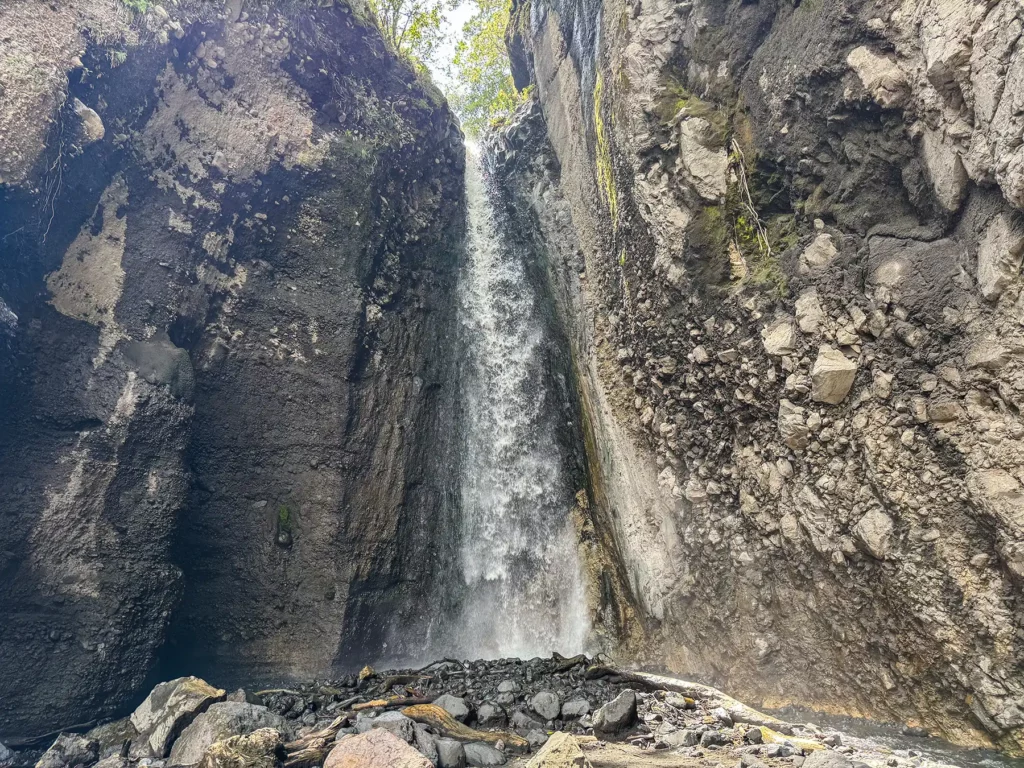
Best Lunch Spots in Arusha National Park
I’m sure that a morning of exploration is going to leave you feeling a little hungry! Ideally, you’ll have a picnic lunch with you so that you can dine al fresco at one of the picnic spots located within the park.
There are two key picnic sites, one by each of the park gates.
To the south of Arusha National Park is Ngongongare Gate which is the main gate to Arusha National Park when arriving from the city. There is a small picnic area with a couple of picnic benches not far from the restrooms at this gate.
The most popular picnic site however is by Momela Gate in the north of the park. There are a few more benches here. It’s popular to stop here for lunch after a morning walk to Tululusia Waterfall and back. Keep your eyes peeled for cheeky baboons and Skye’s blue monkeys who are often enticed to the picnic area by the tantalising smell of lunch.

Are Arusha National Park Safaris Safe?
Arusha National Park safaris are very safe. Additionally, I have always felt safe whilst travelling in Tanzania. However, it’s always wise to be cautious. For further information, you can check out the UK government website for up-to-date travel advice and advisories.
Wildlife & Natural Disasters
In regards to wildlife, there are limited predators in the park which makes it one of the safer parks to go on walking safaris. On a walking safari you will be accompanied by an armed ranger which provides a lot of peace of mind as you wander around on foot. The riskiest animal to encounter is a buffalo but the guides understand their habits very well and know to keep well clear of them. The rifle is used as a last resort to give ‘warning’ shots that scare the buffalos away.
There isn’t a big threat of flooding or natural disasters in Arusha National Park. To decrease your chances of encountering any flooding, I’d advise visiting between mid-March and mid-May when the rains are at their heaviest.
Is Crime an Issue?
Like everywhere in the world, a risk of terrorism is present in Tanzania. However, this is always highest in busy cities and national parks haven’t ever been targets. Crowded areas are most at risk so if you wish to eliminate the risk completely, you may wish to stay in a hotel outside of the city hub. On saying that, Arusha city is still relatively low risk with larger cities like Dar Es Salam being higher risk.
Your biggest risk in Tanzania is petty theft. Crime and petty theft can be an issue in Tanzania, particularly in large, busy cities like Dar es Salaam, Stone Town, and Arusha. Make sure to keep an eye on your valuables at all times and carry as little as possible when you are walking around town. I would also keep my mobile phone out of sight unless taking photos. (In that case, I get it in and out of my bag as quickly as possible.)
I generally leave my passport and excess cash in my hotel room – just make sure that you carry a printed or digital copy of your passport with you in case you need it while you are out and about. I normally hide any valuables that I have among my other belongings. However, if there is a safe in your room, you can always use that for extra security. Just make sure that you empty it before you leave the hotel!
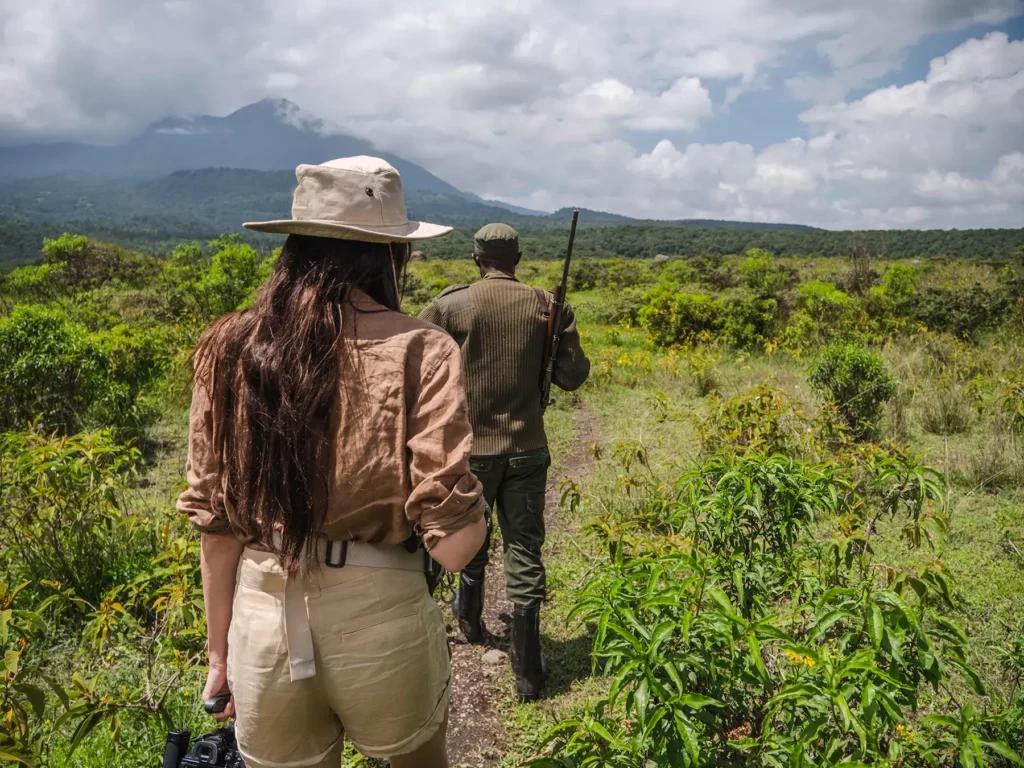
What’s The Safest Way to Travel Tanzania?
Roads in Tanzania can be quite rough, but most professional drivers know how to handle these bumpy roads so you can rest assured that you are in very good hands. If you decide to rent a car and self-drive, make sure that you are familiar with the roads and try to avoid driving at night as much as possible as there are limited road lights and some vehicles don’t even have headlights. The sun sets very early in Tanzania due to its proximity to the Equator so make sure to plan your day accordingly.
Travelling by public transport can carry a few more risks as drivers are often in a hurry to make it to their destination and could take unnecessary risks as a result. If you’re travelling with a reputable tour operator, this shouldn’t be an issue, but I would always read the reviews of any long-distance bus companies as thoroughly as possible to see what feedback people have on the drivers and the overall professionalism of the company.
I’d personally recommend travelling with a tour operator or when travelling around the city, with a reputable taxi company. Choose a company with a large safe vehicle (tour operators have these as standard).
The absolute safest way to travel however is by air. Flying on commercial airlines is remarkably safe. Even so, due diligence is always helpful so if you opt for a fly-in safari, you should always check the safety record of the airline before confirming your trip.

Health and Diseases
The biggest health risk for many travellers is generally food-related illnesses which can put a real damper on a trip and cause you to miss out on game drives and other fun activities. Luckily, it’s usually quite easy to avoid having major issues.
In general, the restaurants at safari lodges typically follow normal hygiene procedures and the food served there is safe to eat. However, I would recommend reading reviews of any hotels and lodges you’re considering to see if there are any comments on food. In my experience some of the more budget-friendly hotels sometimes don’t have the best food hygiene standards and I’ve gotten sick a couple of times this way. Therefore it may be best to stretch your budget for that peace of mind. Safaris aren’t cheap and you don’t want to spend several days in bed with stomach cramps rather than looking for animals.
If you want to try local food being served on the street, make sure to take a good look around to see how hygienic the facilities are. Try to avoid eating meat that may have been sitting outside. If you have a sensitive stomach, it’s also a good idea to eat only fruits that you can peel and vegetables that have been thoroughly cooked.
You should also never drink water from the tap or consume ice cubes as they may have been made with contaminated water. Try to keep this in mind if you’re ordering cocktails or mixed drinks as it’s really easy to forget after a rum and Coke or two! As a general rule, I never have ice in my drinks – it’s better to be safe than sorry.
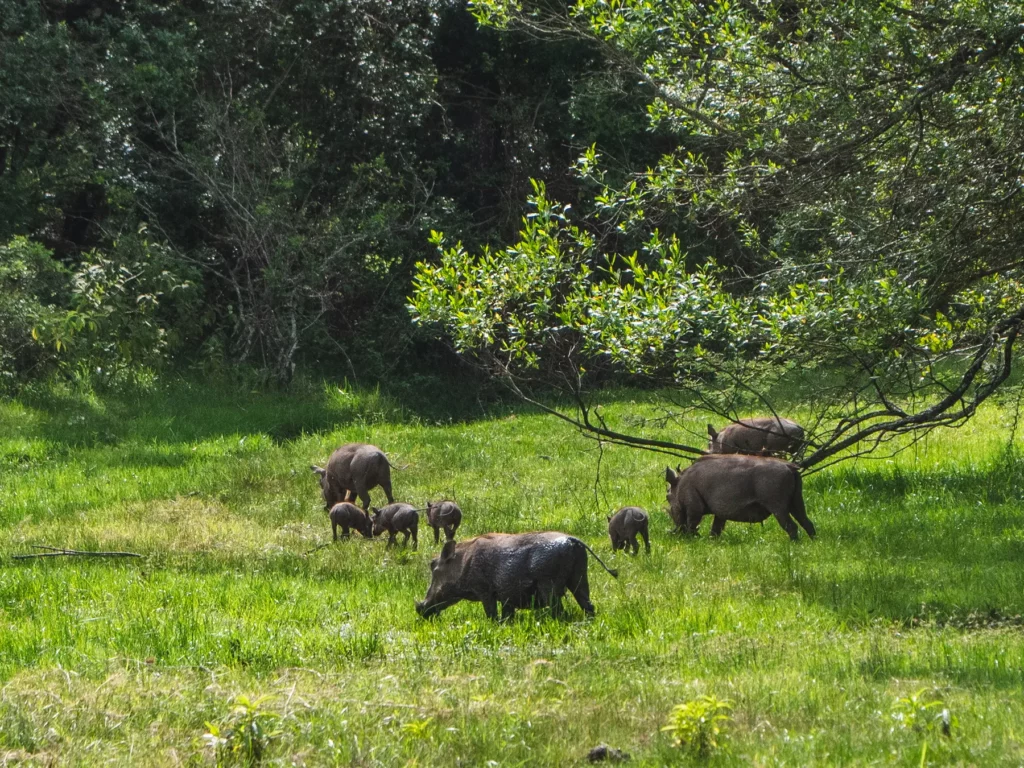
Regarding diseases, we have probably all heard the horror stories about crazy diseases that you can get when in Africa. While I am sad to say that many of these are true, I’m happy to inform you that the chances of any of these affecting you are very small.
Yellow fever and malaria tend to be the biggest concern for many visitors. It’s possible, and often recommended or required, to get yellow fever vaccinations before travelling. You can also take anti-malarial medications to prevent contracting the disease. If you’re considering this, bear in mind that Arusha National Park is a relatively low-risk area due to its high altitude. However, I’d definitely recommend speaking to your doctor about medication options and I personally always take antimalarials when in Tanzania, especially when visiting multiple parks which all have varying levels of risk.

In addition to the above-mentioned illnesses, there is also a concern about tsetse flies. Rest assured that they are actually more of a nuisance than a danger. These flies can be found throughout Tanzania’s Northern Circuit Parks and can transmit African Sleeping Sickness. Symptoms of this illness include fatigue, muscle aches, headaches, and a high fever. If it progresses, it can cause a long-term impact on the central nervous system which can lead to some very big health problems. The good news is that the chances of being infected with the disease are minuscule. Most of the known cases occur in local farmers and hunters who have been bitten many times over many years.
While your chances of getting African Sleeping Sickness are very, very low, it’s still a good idea to avoid tsetse flies simply because they can be very annoying and their bites can be painful. Do not wear blue, black, or bright-coloured clothing and try to stick to neutral tones. Always keep your arms and legs covered and wear insect repellent containing DEET.
Arusha National Park, along with nearby Serengeti National Park and Mount Kilimanjaro, are all considered to be low-risk for contracting malaria, compared to lower lying areas of Tanzania. This should give you some peace of mind. It’s still important to use insect repellent and keep your arms and legs covered in the evenings unless you want to be feasted upon by swarming insects.
I would also still advise speaking to a medical professional about taking antimalarials as Tanzania does have a risk of malaria and if you are embarking on a multi-day safari you will likely journey through areas which have a higher risk of malaria.
The risk of malaria increases when you visit during the rainy season, between November and May.
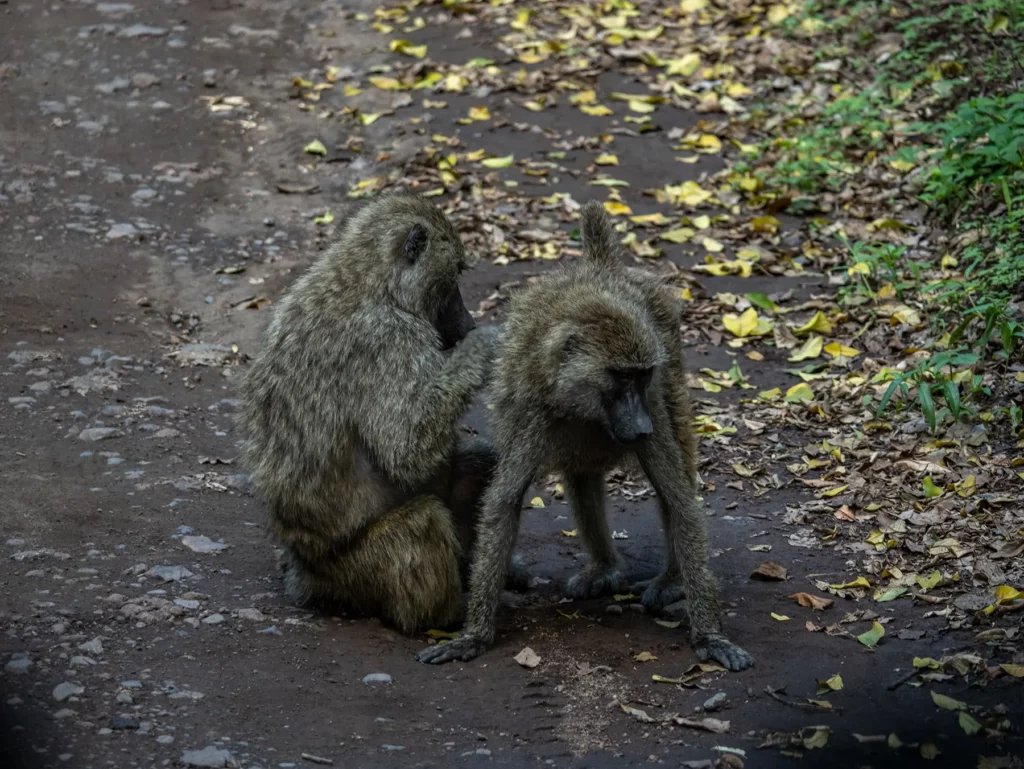

Embark on the Safari of Your Dreams
Save time and ensure an incredible safari experience by getting quotes from my recommended local safari companies
I’m here to make booking your perfect safari quick, easy and risk-free.
Join the rapidly growing tribe of over 1,000 travellers who’ve booked their dream safari using my insider tips and recommendations.

It takes under 60 seconds to fill out the form and in under 48 hours you will receive multiple, no-obligation proposals from my favourite local tour operators with glowing online reviews.
Get your free no-obligation safari quotes and my top safari tips and recommendations
Things to do in Arusha National Park
Arusha National Park offers an exciting array of activities that few other national parks can match! Whether you’re looking for a relaxing boat ride on a pristine lake or a hike so beautiful it will take your breath away (literally!), Arusha National Park has something for pretty much everyone.
You can jump to any of the things to do below.
Can You Go on A Walking Safari in Arusha National Park?
Arusha National Park is one of the few national parks in Tanzania where you can go on a walking safari!
These are perfectly safe due to the lack of predators in the park. While this means that you are unlikely to see a lion, you CAN see plenty of other animals on foot which gives you a completely unique experience!
Several different nature trails are used for walking safaris. Each has something unique to offer in terms of scenery, wildlife, and attractions. Walking safaris can take well over three hours so make sure you bring comfortable walking shoes, plenty of water, and sun protection.
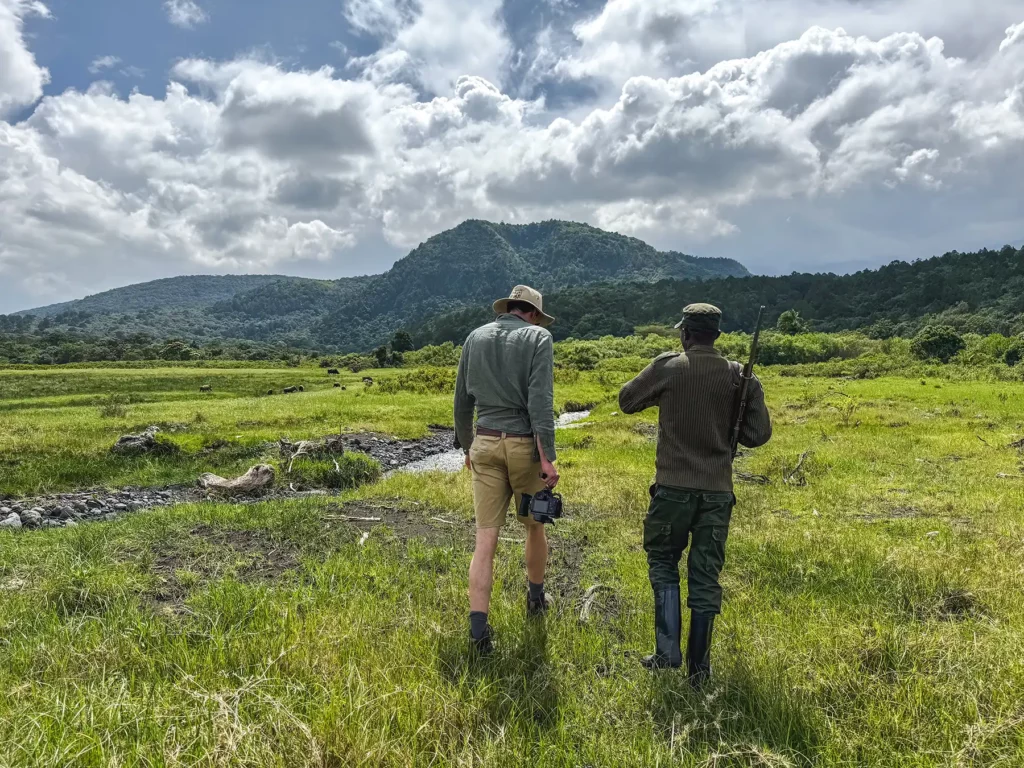
Canoeing Safari in Arusha National Park
Another way to see the park’s wildlife is from the comfort of your very own canoe! Arusha National Park offers visitors the chance to glide along the still water of Small Momella Lake to get an unparalleled view of water birds as they search for their next meal or hang out with their feathered friends. Meanwhile, large game such as giraffes, buffalo, and bushbucks can be seen grazing along the water’s edge.
Hiking Mount Meru in Arusha National Park
Stretching 26.7 miles (43 km) round-trip, the hike up Mount Meru normally takes three to four days when following the popular Momela route.
This challenging trek takes hikers through an incredibly diverse landscape starting with lush rainforests at the bottom and culminating in high alpine terrain as you near the summit. As the icing on the cake (err….mountain?), the slopes of Mount Meru offer refuge to not only weary hikers but also buffalo, baboons, warthogs, and more. If you’re lucky, you may find yourself sharing the trail with a furry friend!
Often called a ‘warm-up’ for Mount Kilimanjaro, Mount Meru provides an excellent way to get your hiking legs ready for the climb up Kili! That said, the Meru summit itself makes for a superb hiking goal.
If you don’t have the energy, money, or time to do the full hike of Mount Meru, don’t worry. The park has many day hikes which take around seven hours in total. While you don’t get to reach the summit, you still have the chance to see a lot of wildlife and get a different perspective of the park’s unique topography.

Can You Go on Night Game Drives in Arusha National Park?
Although it’s not possible to go on night game drives in Arusha National Park, you can organise this in other Northern Circuit parks such as Lake Manyara National Park and Tarangire National Park.
Can you go on a Balloon Ride in Arusha National Park?
Unfortunately, it’s not possible to go on a hot air balloon ride in Arusha National Park. However, you can easily arrange this later on your trip to nearby Serengeti National Park. It normally costs between $500 and $600 per person and the flights only depart when the weather is good. I know that this is usually a once-in-a-lifetime experience for people but try not to put pressure on hot air balloon operators to go out during inclement weather as this can be dangerous for both you and the pilot.
Most hot air balloons take off in the early morning when the weather is at its most stable, giving visitors stunning views of the sunrise over the savannah. While getting up in the wee hours of the morning isn’t always fun, you are rewarded with a champagne brunch at the end of the flight as well as numerous animal sightings. Sightings can include the great wildebeest migration, herds of elephants and even prides of lions!
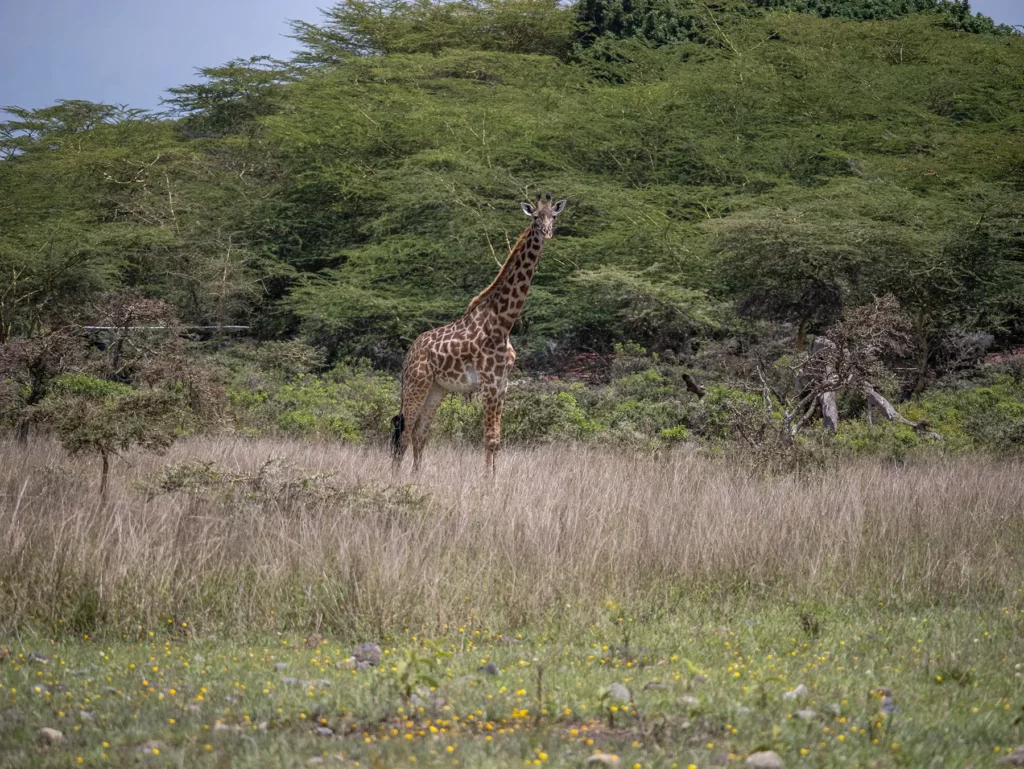
Can You Go Horseback Riding in Arusha National Park?
All the horse lovers out there will be extremely excited to hear that you can go on a horse riding safari in Arusha National Park. It’s one of the few national parks in Tanzania where you can view wildlife from the comfort of your saddle.
Novice riders and experienced equestrians alike can take part as you meander your way through well-maintained tracks, spotting a variety of animals as you plod along. Horseback riding safaris normally last a few hours, leaving you with plenty of time for canoeing on Small Momella Lake or a game drive.
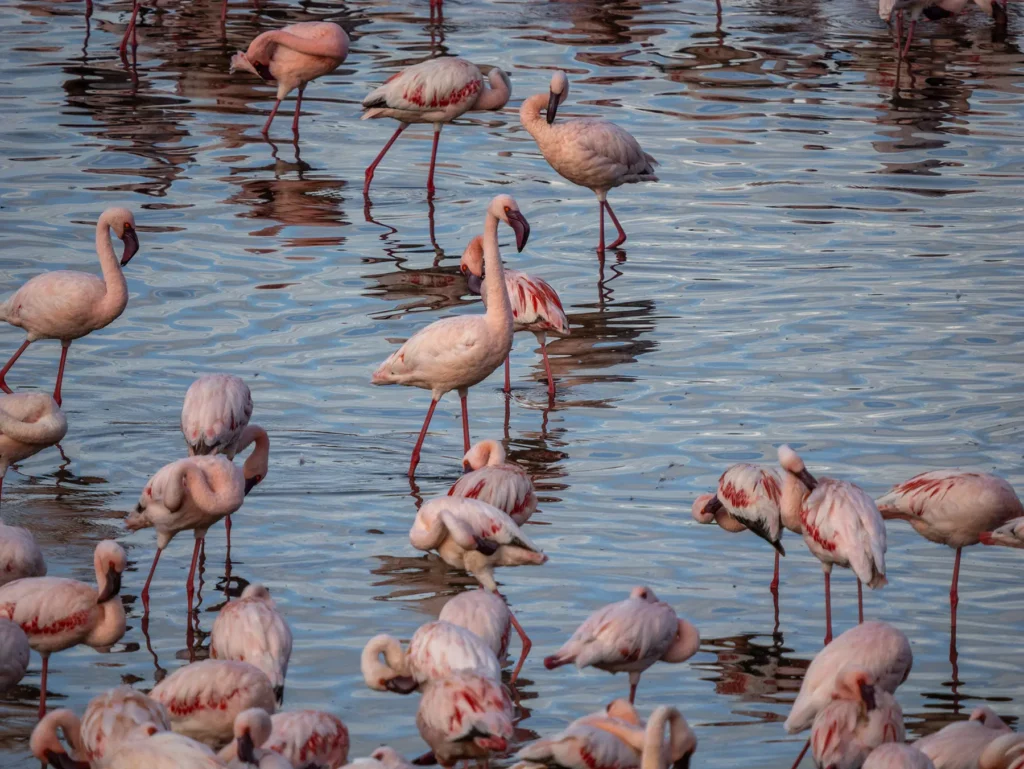
Photographic Safari in Arusha National Park
Picture this, an iconic photo of giraffes striding across a mountainous landscape surrounded by lush trees while Mount Meru stands proudly in the distance. Pretty great, huh?
Simply put, Arusha National Park is a nature photography lover’s dream come true! The large variety of herbivores and birds gives amateur photographers plenty of inspiration while the amazing topography provides the perfect backdrop for a photo safari.
The best time to visit the park if you want to capture some great shots is early in the morning or right before sunset during the Golden Hour. This is when the animals are most active so you have a better chance of getting a good photo of animals in motion. It’s also when you’ll have the best lighting because the sun isn’t quite as harsh as in the middle of the day.
Many tour operators have the option of hiring a photography specific Land Cruiser which has open sides and often come with beanbags to help you support your camera. The open sides allow you to get lower angle shots which is a photographer’s dream!

How to Book your Arusha National Park Safari
Once you have decided to add Arusha National Park to your Tanzania itinerary, you need to figure out exactly how you want to book it. There are a few different options and your final decision is likely to be impacted by whether or not you are including the park in a longer Northern Circuit itinerary or having it as an add-on for a shorter trip.
You can jump to more information on each of the booking options using the links below.
Recommended Booking Options For Your Arusha National Park Safari Itinerary
Private Safari
Most popular & best experience – typical prices for this itinerary start from $300 per person per day.
Visit safarisbyella.com for free quotes from trustworthy local tour companies I use to book my own trips.
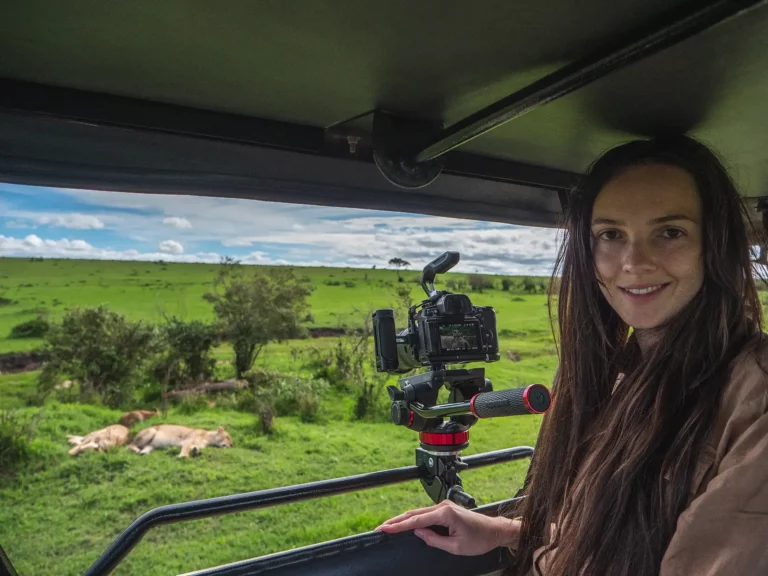
Group (Shared) Safari – Usually Camping
Good for budget or solo travellers – from $220 per person per day.
My recommended Tanzania tour operators only provide private safaris, however, I’ve listed the best and most similar group options for this itinerary, on SafariBookings below.
These group options include Arusha National Park as part of their safari itinerary
Click the link below to request quotes for the group safari options on the SafariBookings website.
1-Day Group Safari to Arusha National Park with Walking Safari
3-Day Group Safari to Arusha National Park, Ngorongoro Crater & Lake Manyara
8-Day Group Budget Camping Safari including Arusha National Park
View All My Recommended Group Options Following a Similar Itinerary
Option 1: Self-Drive Safari
Thanks to its small size, Arusha National Park is a good place to have your own DIY self-drive safari. You simply need to fill out a registration form, pay park permits, and get a ranger assigned to you. While this is a great way to save a little bit of money and have a bit more freedom than you would on a safari tour, it does make it quite difficult to spot the animals unless you are with an expert.
Normally, I don’t recommend self-drive safaris because, in my experience, the amount that you save doesn’t make up for the amount that you don’t get to see. However, if you are visiting Arusha National Park as an extension of a longer trip and simply want to find a way to fill up some downtime in Arusha, a self-drive safari should be fine. It’s one of the better parks to self-drive in Tanzania and allows most vehicles.
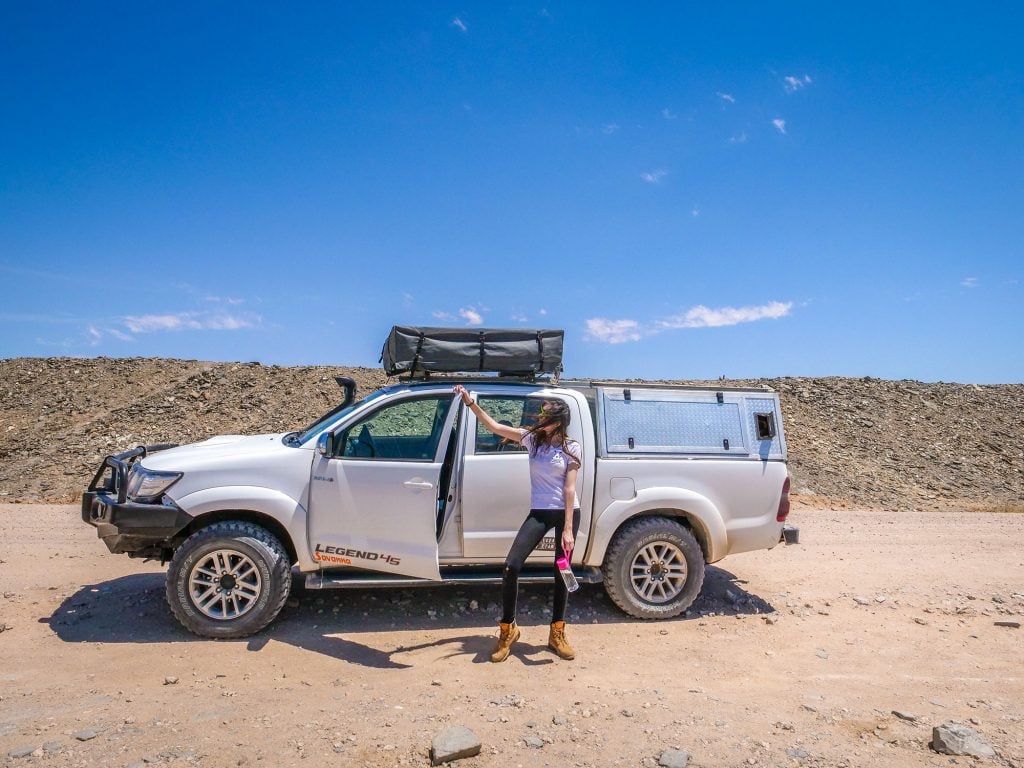
However, I don’t recommend self-driving Arusha as a quick treat after a short business trip or during a flight layover. If you don’t have long in Tanzania, I highly recommend booking a day tour with a local operator as they can ensure that your time is used most efficiently and that you’ll see as much as possible within a short period.
Additionally, if you wish to visit multiple parks in Tanzania, it makes sense to book your entire safari together with a local tour operator, including your visit to Arusha National Park.
How to Book a DIY Self-Drive Tanzania Safari
- Option 1: Comparison sites which provide multiple quotes from verified suppliers such as Safaris By Ella. Make sure to write you want to self drive in the notes when requesting a quote. (This is a hybrid approach where you’ll drive yourself but they will arrange everything)
- Option 2: Research and book all elements of the trip yourself using Google and online travel agents.
Join the rapidly growing tribe of over 1,000 travellers who’ve booked their dream safari using my insider tips and recommendations. Get your free quotes and my top tips and recommendations now.
Option 2: Local Tour Operator
Local tour operators can help you organise your entire safari regardless of whether you are only visiting Arusha National Park or hoping to hit the whole Northern Circuit.
At first glance, local operators may often seem more expensive than doing your own self-drive safari. But, when you start taking a closer look at all the costs associated with your trip, you may find that the costs are actually quite comparable. One of the reasons behind this is that tour operators usually own their own 4×4 vehicles and often have access to discounted rates from different accommodation providers.

Once you have figured out the true cost comparison between a self-drive safari and booking with a local tour operator, it’s time to weigh up the added benefits of having a safari guide with you. Having a guide with you makes it much easier to spot wildlife (which in all honesty is exactly what you came here to do, right?) as they are extremely familiar with the landscape and the behaviour of the animals themselves.
I always use my favourite local tour operators these days as I find them to be the best optional all-round.
How to Book with the Best Local Safari Companies
- Comparison sites which provide multiple quotes from verified suppliers such as Safaris By Ella
Join the rapidly growing tribe of over 1,000 travellers who’ve booked their dream safari using my insider tips and recommendations.
Option 3: International Travel Agents
If this is your first time visiting Africa, you may be tempted to book with an international travel agent. Knowing that there is a big company behind you can certainly make you feel more comfortable embarking on this journey, even if that means spending often double what it would cost to book through a smaller outfitter.
However, it’s really important to consider the fact that most of the international travel agents work with local tour operators who actually do all the groundwork for them.
Yep, you read that right. No matter if you book with a large international company or a small local tour provider, you are probably going to end up travelling with the same tour guides and drivers. The only difference is that you probably paid much more for the experience if booking with an international travel agent. This is one of the reasons why I highly recommend booking directly with the local tour operator.
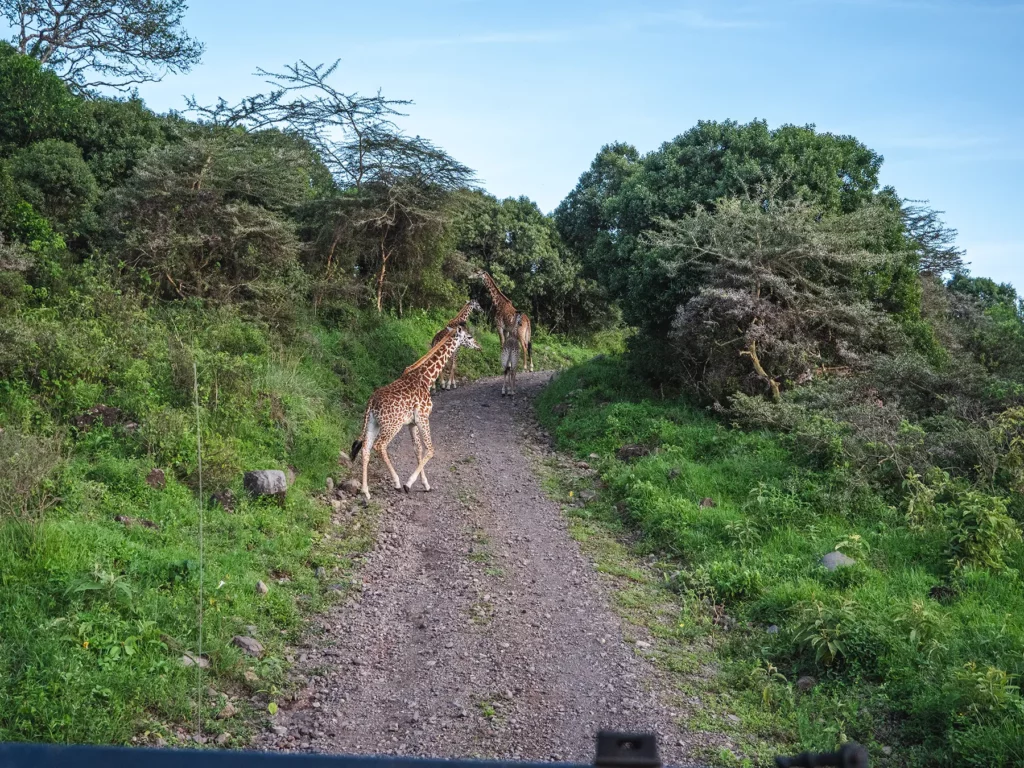
The benefit of international travel agents is that In the UK you will be covered by Package Travel Regulations and If they book international flights as part of your package, you will be covered by the ATOL scheme.
In America there are schemes such as the Airline Passenger Protection Act and the Federal Aviation Administration’s consumer protection rules which apply when booking through a local travel agent in the US.
There are, however, steps you can take to protect against these risks yourself when booking directly with local suppliers such as using your credit or debit card to make payment for the deposit as these typically offer purchase protection (In the UK it’s called Section 75).
Purchasing good travel insurance with travel interruption protection or similar.
Finally, choose a recommended local safari company as they will usually allow you to make balance payment near to the trip date which further minimises any risk.
How to Book Your Safari with an International Travel Agent / Safari Company
- Comparison sites which provide multiple quotes from verified suppliers such as Safaris By Ella. When you select a luxury budget on the quote request, you will receive a quote from my recommended International safari company as well as my recommended local companies for comparison.
Join the rapidly growing tribe of over 1,000 travellers who’ve booked their dream safari using my insider tips and recommendations.
Option 4: Fly-In Hotel Safari
If you have a big budget to play with and want to limit the amount of time spent driving from one place to another, you could always look into a fly-in hotel safari. During these tours, you fly in light aircraft between locations.
You can either use scheduled flights which will go to the most popular airstrips from where you will be picked up by the accommodation’s vehicles. Alternatively you can use the more expensive private chartered flights, which can fly directly to the accommodation’s private airstrip, if they have one, which reduces any transit time from the airstrip to the accommodation.

Game drives will usually be organised by the lodges.These are usually group safaris which can lack flexibility compared to a private safaris. You can also use a safari company for the game drives instead to ensure you have a private safari with your preferred guide.
Private safaris give you the option to wait longer at sightings or take a more leisurely pace to see the more elusive wildlife. Group safaris normally rush around a bit more with the aim to see as many sightings as possible. However I have found my most memorable sightings have been when we’ve waited, sometimes for hours for an incredible sighting such as a leopard eating a kill in a tree or a successful hunt.
There are two main reasons for booking a fly-in hotel safari:
- Fly-in safaris can be a really good way to see many different parks within a short period but you’ll have to pay a hefty price for this luxury.
- You plan to spend a lot of time at one accommodation and only plan to do a short-game drive each day or intermittent longer game drives, in which case it might not make sense to have a dedicated safari vehicle and driver with you for the full trip.
How to Book a Hotel-Provided Safari
- Option 1: My recommended tour operators on Safaris By Ella can arrange hotels and air or road transport to and from the hotels. If you opt for the more cost-effective road transport, since they have driven you to the hotel, you might find it cheaper to use the safari company for safaris rather than using the hotel-provided safaris.
- Option 2: Check with your chosen accommodation whether they provide this service and the booking requirements.
Arusha National Park Safari Prices
In this section we’ll dig into the costs of visiting Arusha National park.
You can also see my Complete Guide to Tanzania Safari Costs for more information on safari costs in Tanzania.
Below is an overview of Tanzania safari costs by luxury level.
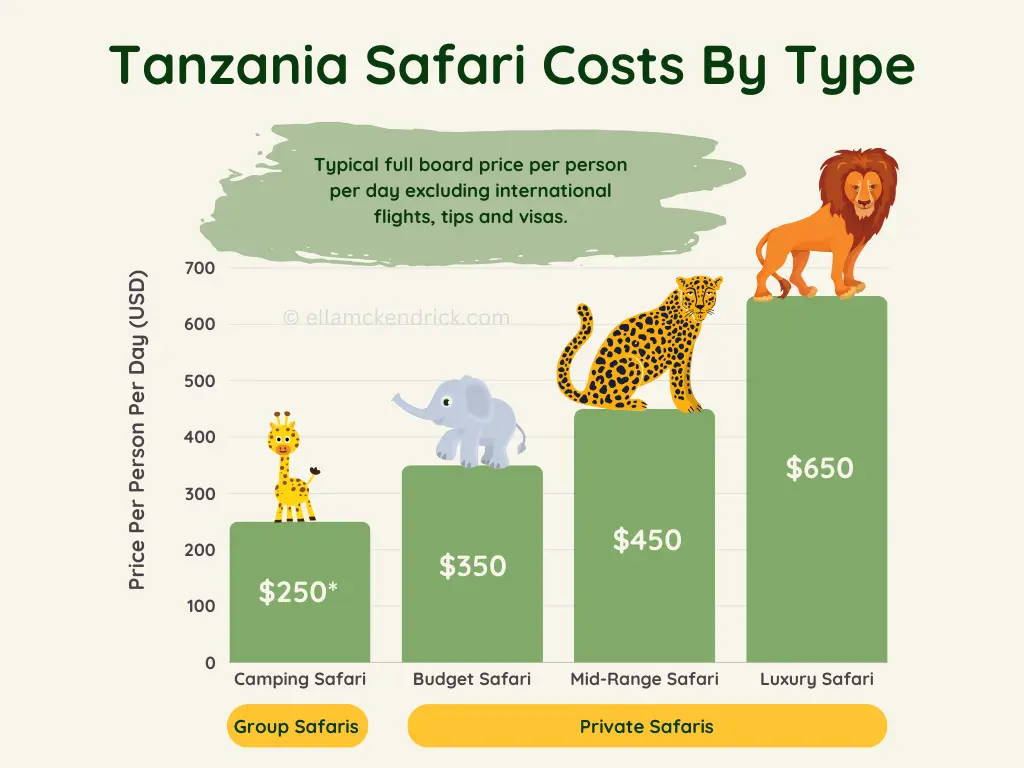
How Much Does an Arusha National Park Safari Cost?
As far as Tanzania park fees go, Arusha National Park is on the cheaper side, costing $50 per person in the high season and $45 in low season.
Due to its close proximity to Arusha city, you can visit Arusha National Park as a day trip with a safari company. You can expect to pay around $160 – $230 per person for this experience, based on two people sharing a private safari vehicle.
Price includes private safari vehicle, driver / guide, park fees and permits. You can also request to include a walking or boating safari as part of your main safari.
As part of a multi-day Tanzania safari including the more expensive parks such as Serengeti National Park, prices typically start at around $350 per person per day for private safaris and $250 for group safaris. These prices include full board accommodation.
Let’s take a look at how these costs break down in the case of a local Tanzania safari company.

How Much Does it Cost to Enter Arusha National Park?
Arusha is one of the cheapest national parks to visit in Tanzania, especially when comparing the costs to the country’s most famous parks, such as Serengeti, Kilimanjaro, or Ngorongoro Crater.
Arusha National Park entry fees are $50 per adult and $15 per child. (Adult fees are reduced to $45 during the low season, from 15th March to 15th May).
As this national park is close to Arusha city, nearby accommodation prices are lower than most of the country’s major safari destinations, where the only option is to stay within the park or near the gates, which hikes up their prices. In Arusha city, you can expect to pay around $25 (budget), $90 (midrange) or $180 (luxury) per night during peak season.
On top of this, you’ll have to pay for any activities you want to do during your visit. If possible, I recommend doing a walking safari in Arusha as it’s one of the only Tanzanian national parks that offers them. Walking safaris usually cost around $150 – $200 per person per day. You’ll be accompanied by an armed ranger and group numbers are limited to six tourists.

Is an Arusha National Park Safari Worth it?
After visiting many of Tanzania’s national parks, I can honestly say that Arusha National Park is worth it.
Although the park is significantly smaller than most of the other parks on the Northern Circuit, the high number of animals makes them easy to spot. Since there are very few predators, the large herbivores also tend to be a little bit more chilled out which makes it easier to get great photos of them!

The landscape was another highlight for me. The lush jungle is so different from other parks in Tanzania and let me tell you, spotting giraffes in the jungle is a sight to remember! The waterfalls and Momella Lakes also add to the magic of this small pocket of wilderness.
Arusha National Park also offers a really wide variety of activities. While safaris in the Serengeti and Ngorongoro are spectacular, it can start to feel a bit tedious spending many days on end sitting in the back of a jeep. Meanwhile in Arusha, going for a day hike or a canoe ride can help you get your body moving again. (If you’re keeping an eye on your budget, these activities tend to be cheaper than adding on another driving safari, too.)
Finally, the fact that Arusha National Park doesn’t get the same crowds as Serengeti National Park is one of the things that makes it even more worth visiting. Having fewer people in the park can help you feel more connected with nature and all the magnificent animals here.

Where to Stay in Arusha National Park
At the end of an exciting day, I’m sure that you will be ready to lay your head in a comfy bed! There are quite a few different accommodation options available so you are sure to find something that suits your budget and taste.
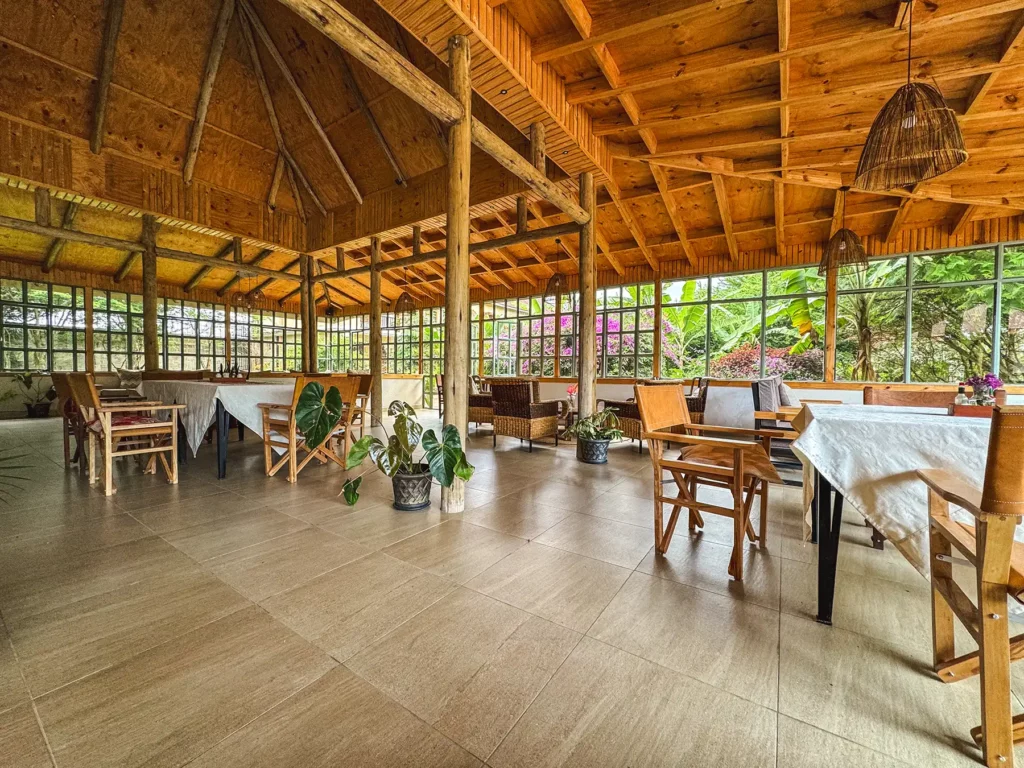
Hotels
Arusha is considered by many to be the de facto capital of East Africa. This, combined with its popularity as a tourist destination, pretty much guarantees that you’ll have a wide range of accommodations to choose from.
If you have the budget, I suggest staying in one of the safari lodges located near Arusha National Park. This gives you the full ‘safari experience’ as you’re close to nature.
Some of the most well-known lodges near the park include the Ngurdoto Mountain Lodge, a swanky five-star resort, and the Momella Wildlife Lodge, which features rustic cabins, just over one kilometre from the park gate. Another great accommodation option is Elewana Arusha Coffee Lodge which lies at the foot of Mount Meru. The hotel is situated in an old plantation house and surrounded by smaller cottages.
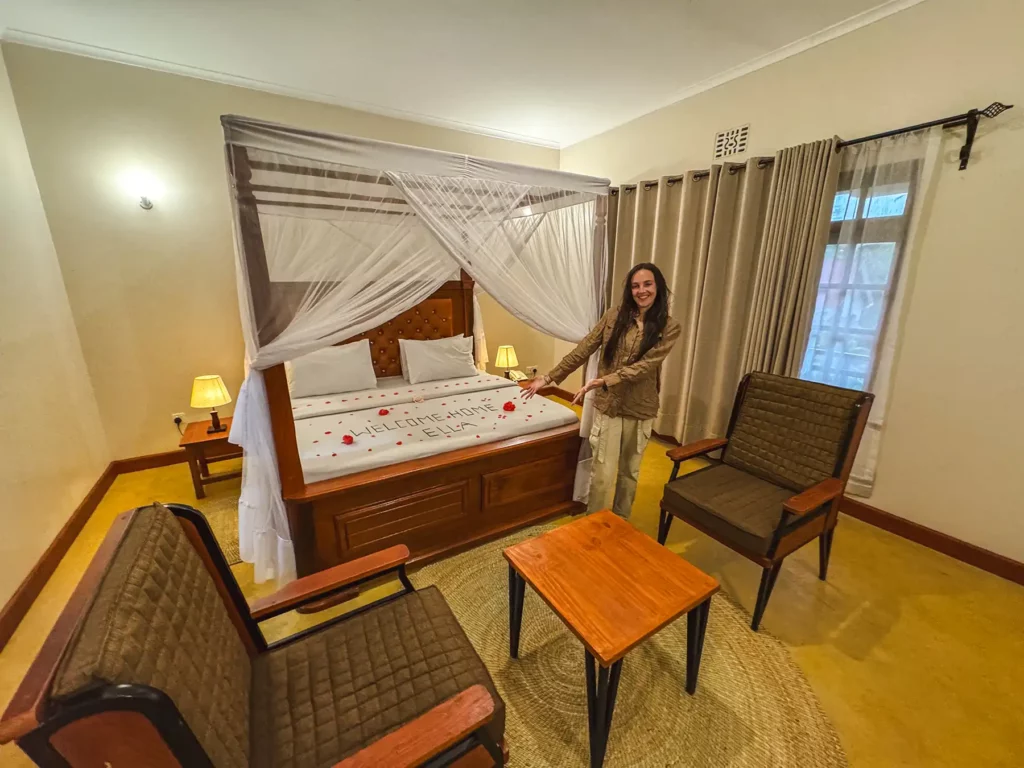
Airbnbs
If you are travelling with family or a large group, you may want to consider booking an Airbnb. Airbnbs often give you all the creature comforts of home while you are on the road which can make travelling with young kids much, much easier. Keeping everyone in the same space can also help get everyone out the door on time when you are heading out for safaris or other activities.
While Airbnbs are also handy for adults who prefer privacy and cooking their own meals, the one major con that I have found with Airbnbs is that you often don’t have the same level of service that you would at a hotel. Although I love having my own space and the convenience of a kitchen and other amenities, I sometimes miss having access to hotel staff who can help answer any questions. For example, hotel staff can make things much easier when you’re trying to get a taxi to the airport or figure out the best time to visit a local craft market.
When choosing an Airbnb, I would read guest reviews to see how responsive or helpful a host is, as having a good host can really give your trip an extra something special.

Hostels
In addition to hotels and Airbnbs, there are also a few different hostels in Arusha that cater to people travelling on a budget. Hostels are particularly good for solo travellers as you could potentially find someone to go on safari with, thereby greatly reducing your overall travel costs.
Another great benefit of hostels is that most of them have a common sitting area where you can catch up on work, watch Netflix, or just chill out. Most offer a kitchen where you can make your own breakfast or prepare a much-needed cup of coffee before heading out for a sunrise safari.
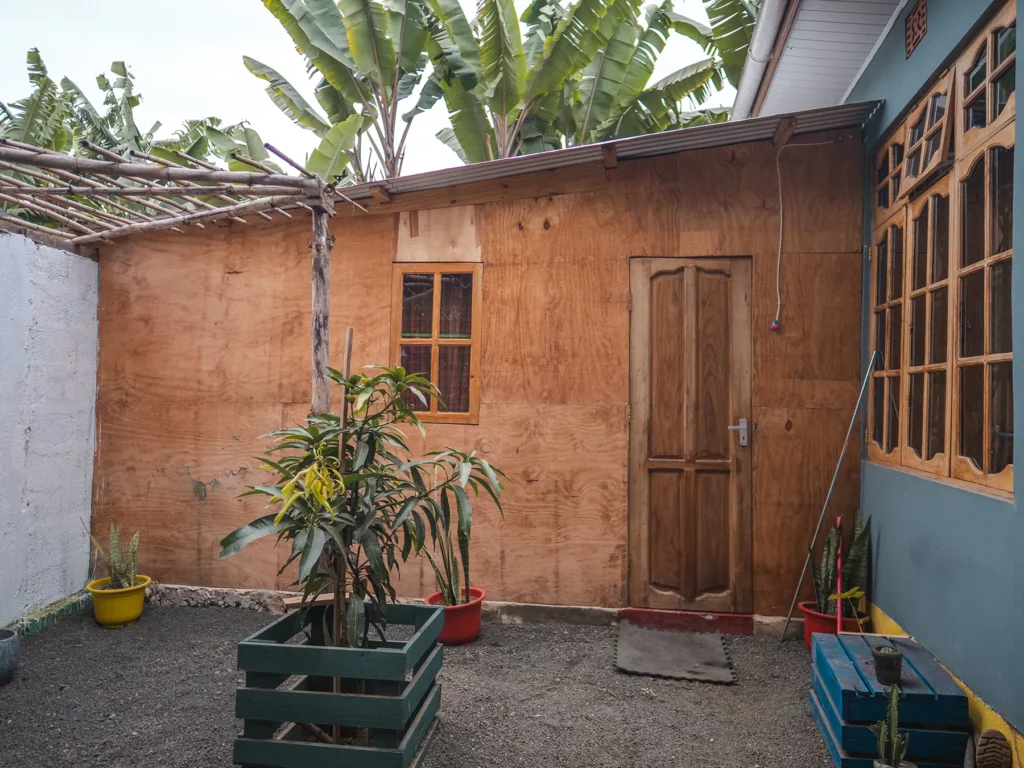
You can find everything from eco hostels to city centre dwellings near Arusha National Park. Prices are extremely reasonable compared to other destinations in Africa and many hostels have a mixture of private rooms and dorm rooms which means that you don’t have to share a room with a stranger if you don’t want to!
Some of the best-rated hostels in Arusha include Banana Farm Eco-Hostel, the Osotwa Maasai Hostel and the Green Garden Hostel, both of which offer private rooms. Although these properties don’t have all the bells and whistles of the safari lodges, they cost a fraction of the price. Another great option is the Mufasa City Hostel and Apartments which has everything from 4-bed dorm rooms to one-bedroom apartments.
You can watch a vide of my experience at Banana Farm Eco-Hostel below.
Getting to Arusha National Park
In this section I’ll cover your options for getting to Arusha National Park.
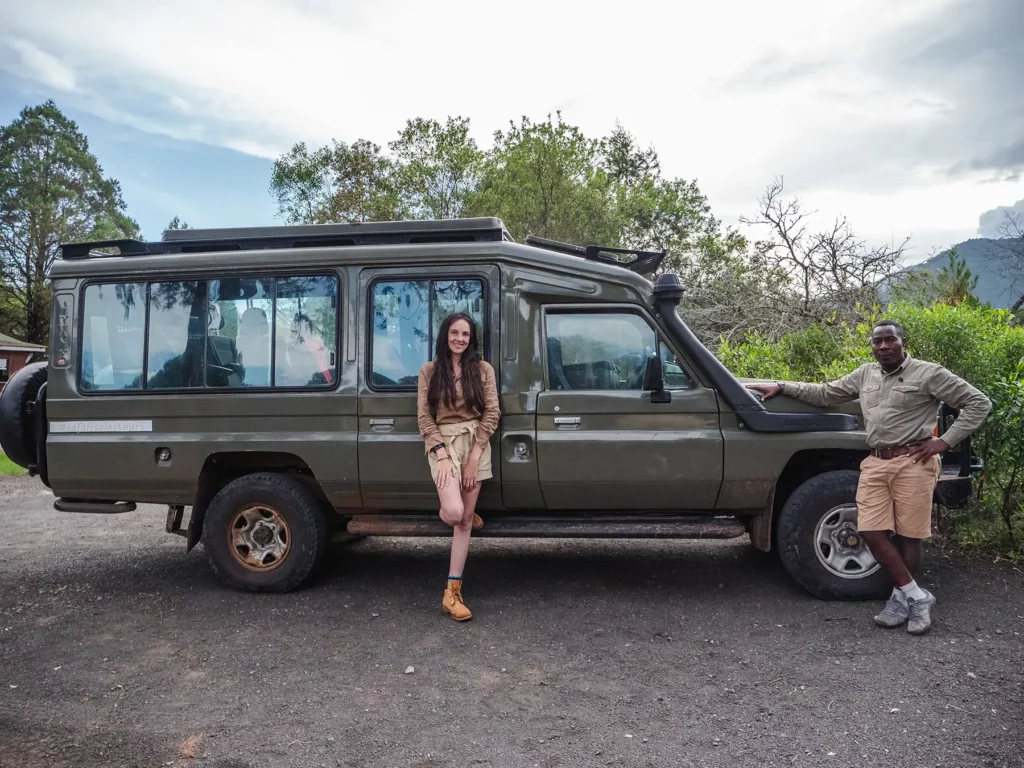
What city is closest to Arusha National Park?
Arusha is the closest city to Arusha National Park. Besides offering a wide variety of amenities and services, it also has northern Tanzania’s only international airport: Kilimanjaro International Airport.
Where do you fly to get to Arusha National Park?
Arusha’s international airport is known as Kilimanjaro International Airport. This airport welcomes domestic and international flights. An hour away from the international airport, Arusha Airport only handles a handful of infrequent domestic flights so chances are high that you’ll be flying into Kilimanjaro, but make sure that you double-check this when making travel arrangements.
Kilimanjaro International Airport is roughly a 45-minute drive from Arusha City and about an hour and a half from Arusha National Park. It’s possible to get a taxi or hire a rental car at the airport. If you are on a tour, your tour guide will likely meet you at the airport and provide transport to your accommodation.
Is Kilimanjaro Close to Arusha National Park?
Yes! Kilimanjaro International Airport is the closest international airport to Arusha National Park. From there, you can take a taxi or shuttle to Arusha city in 45 minutes.
Alternatively, you can hire a rental car and drive directly to Arusha National Park. The total drive time will be around 90 minutes.

How Does Arusha National Park Compare with other Safari parks?
Arusha National Park is much smaller than some of Tanzania’s iconic safari parks. However, what the park lacks in size, Arusha certainly makes up for in quality! I have broken down how I would compare it to other parks below which should hopefully help you make a final decision as to which parks to include in your itinerary!
Which is Better, Serengeti or Arusha National Park?
Due to the sheer size difference between the two parks, comparing Serengeti National Park and Arusha National Park is kind of like comparing apples to oranges.
A UNESCO World Heritage Site since 1981, Serengeti National Park measures nearly 9,320 square miles (15,000 square km). It’s home to nearly 1.3 million wildebeests, 150,000 gazelles, 60,000 zebras, 3,000 lions, 1,360 elephants and healthy populations of spotted hyenas, rhinoceroses, leopards, hippos, and more. This means that you are much, much more likely to see the Big Five in Serengeti than in Arusha National Park.
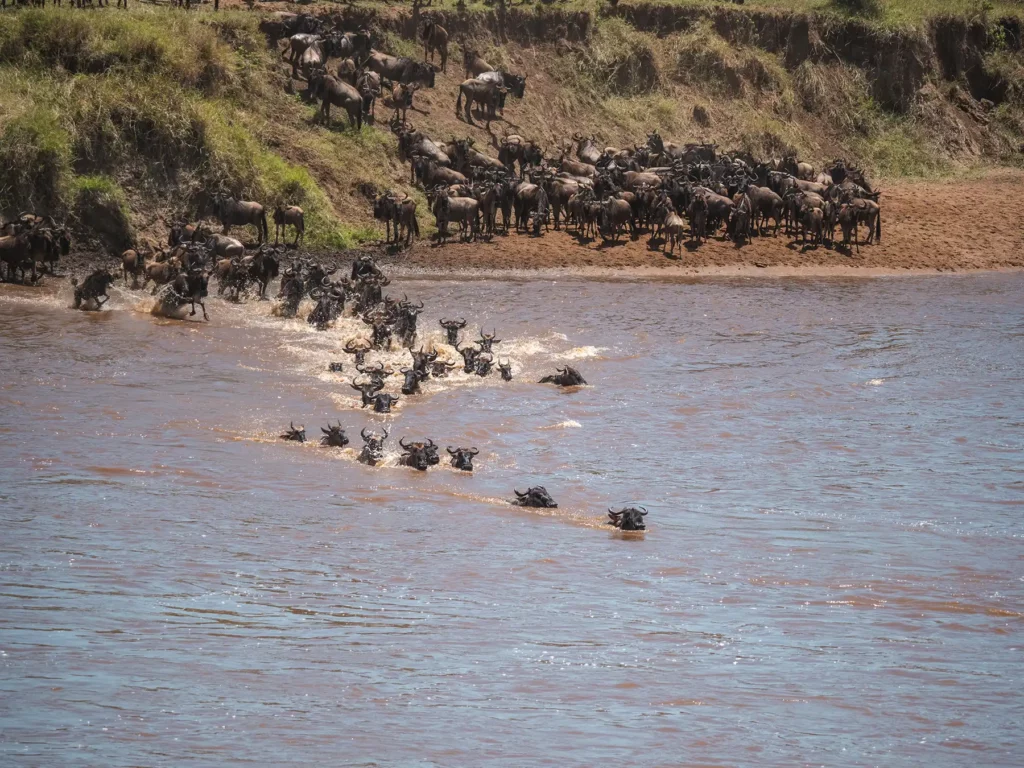
Serengeti National Park also hosts the annual Great Migration when over two million wildebeests and zebras make their way north through the Serengeti as they search for greener pastures. This is one of the biggest highlights of people’s trips to Tanzania so it’s definitely not to be missed.
Ranging from $60-70, the park fees to enter Serengeti National Park are considerably higher than the fees for Arusha National Park. Accommodation prices also tend to be much higher than what you will find in Arusha with hotel rates starting from $150 – 200 per night for a basic tented camp.

When considering the costs involved in visiting each of the parks and the likelihood of seeing animals, it’s safe to say that Serengeti National Park is a must-see. However, this certainly doesn’t mean that Arusha National Park should be overlooked as it has a lot to offer visitors.
For more information you can read my full guide to Serengeti National Park or watch the video below.
Is Tarangire or Arusha National Park Better?
As Tanzania’s 6th largest national park, Tarangire National Park stretches 965 square miles (2,500 square km) and is famous for its large elephant herds.
Nestled between the Maasai Steppe and the lakes of the Great Rift Valley, the Tarangire River flows through the park, and is one of the only water sources in the area, drawing in large numbers of wildebeests, gazelles, zebras, and elephants, along with more than 700 lions. Like Serengeti, Tarangire has a wildlife migration, although much smaller in scale with roughly 250,000 animals crossing the park each year.
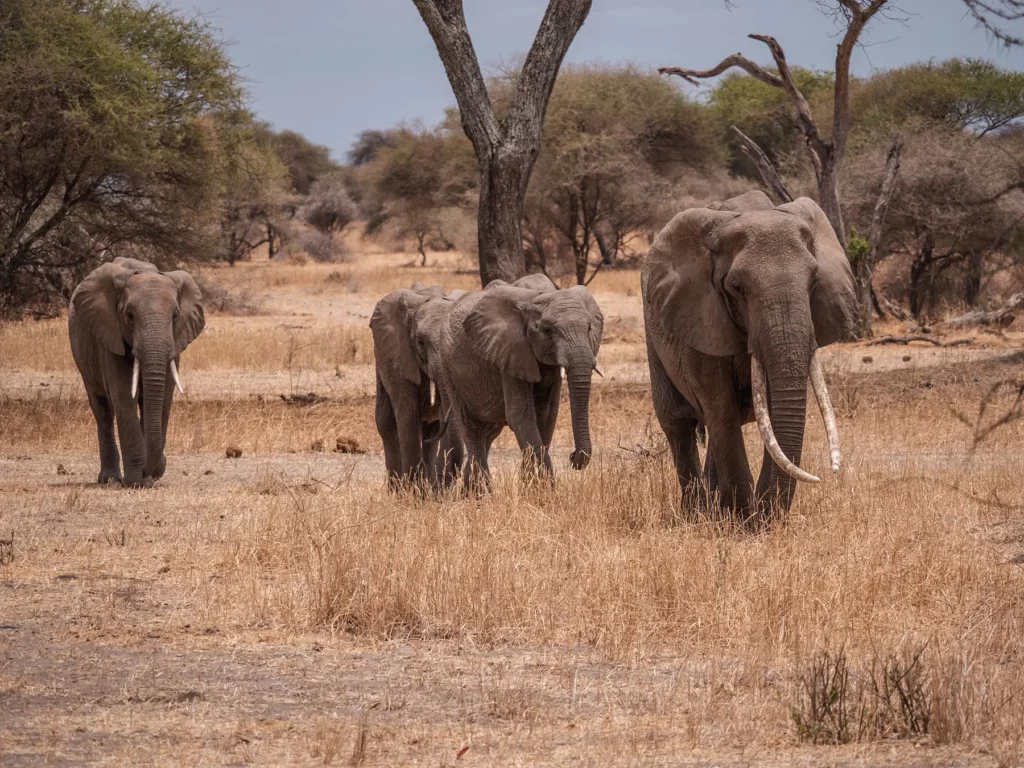
While Tarangire has more animals than Arusha National Park, it lacks the show-stopping scenery (with the exception of Tarangire’s iconic baobab trees). Accommodation prices are roughly the same as what you will find in the Arusha area, but you aren’t likely to find much backpacker-friendly accommodation there. Entry fees are the same as Arusha National Park.
Whilst I love Arusha National Park, the density of wildlife in Tarangire does swing it for me slightly.
You can watch a video of my experience visiting Tarangire National Park below.
Is Ngorongoro or Arusha National Park better?
Known for having one of the highest densities of animals in the entire world, it’s hard to beat Ngorongoro Crater. The crater is the largest unbroken volcanic caldera on the planet and inside, you’ll find over 25,000 animals, including all of the Big Five. In fact, it’s considered one of the best places in Africa to spot all of these animals.
Ngorongoro also boasts Africa’s highest number of predators per capita with 55 lions living on the crater floor alone. You’ll also find more than 7,000 wildebeest, 6,000 black spotted hyenas, 4,000 zebras, 300 elephants, and 30 black rhinos.
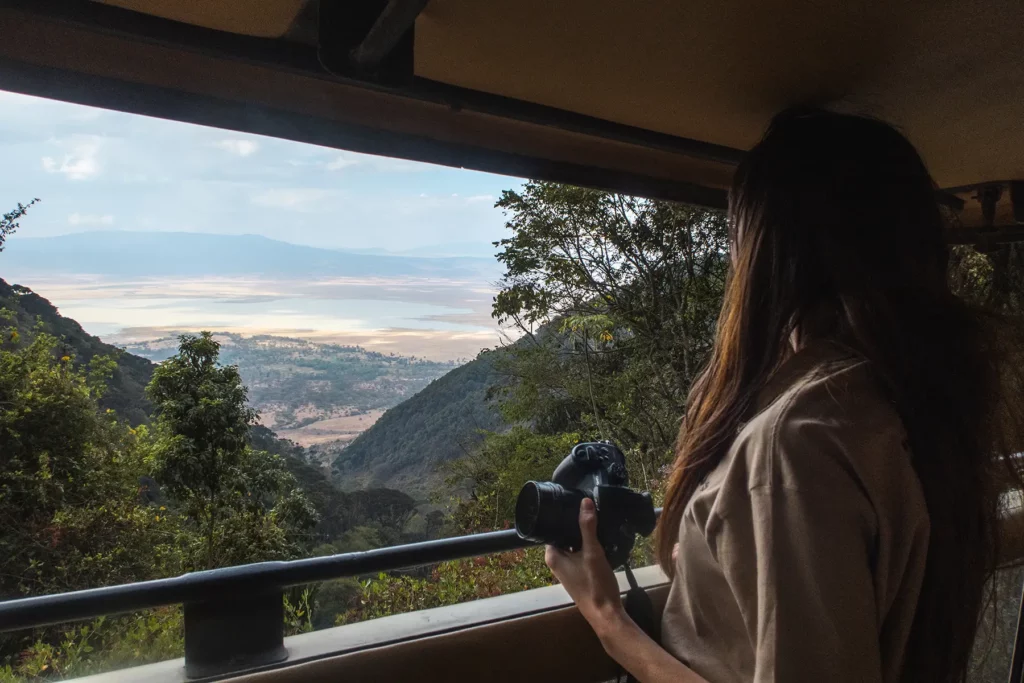
The crater also comes with a fascinating past. In the middle of the 20th century, esteemed archaeologists Dr. Louis and Mary Leakey visited Olduvai Gorge which sits within Ngorongoro Conservation Area and discovered the fossils of some of our earliest human ancestors! Their discoveries greatly increased our understanding of human evolution, so it’s no wonder that the gorge is often referred to as the ‘Cradle of Mankind.’
However, Ngorongoro Crater is one of the most expensive destinations in Tanzania with park fees coming out at $70 per person plus a $400 vehicle fee. There also aren’t a huge amount of accommodation options right at the crater edge, and the ones that are here are very pricey. However, there are some good options in nearby Karatu town which is about 20 kilometres away.
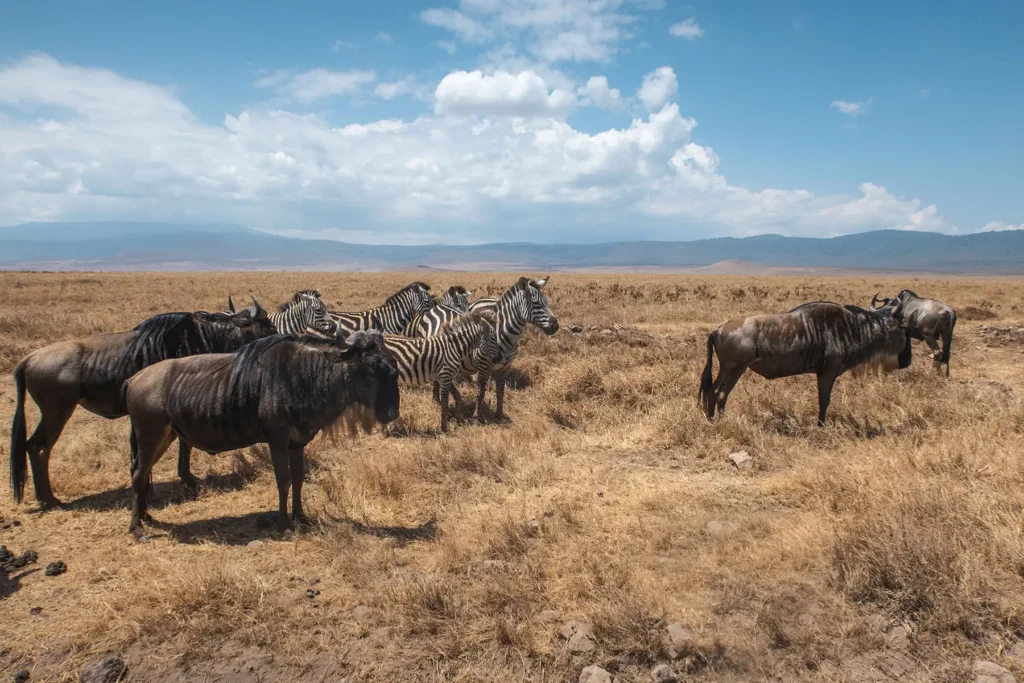
Ngorongoro Crater is one of the most famous safari destinations in the world and it truly is hard to beat. If you have a limited amount of time, this should be at the very top of your list.
For more information you can read my full guide to Ngorongoro Crater or watch my video below.
Is Lake Manyara National Park or Arusha National Park better?
Lake Manyara National Park is located between Lake Manyara and the Great Rift Valley. It covers approximately 125 square miles (325 square km), making it more than double the size of Arusha National Park. It is around 71 miles (115 km) southwest of Arusha and takes about two hours to reach.
Much like Arusha National Park, Lake Manyara has thick forests which sets it apart from many of the Northern Circuit’s big parks. The park has more elephants than Arusha but sometimes the animals are quite far from view.
It costs $50 to enter Lake Manyara, making it similarly priced to Arusha National Park. You can also visit the park as a long day trip from Arusha but it does take around two hours to get there. Alternatively, there is a wide variety of accommodation located in Mto wa Mbu which is about 20 kilometres away from the park.
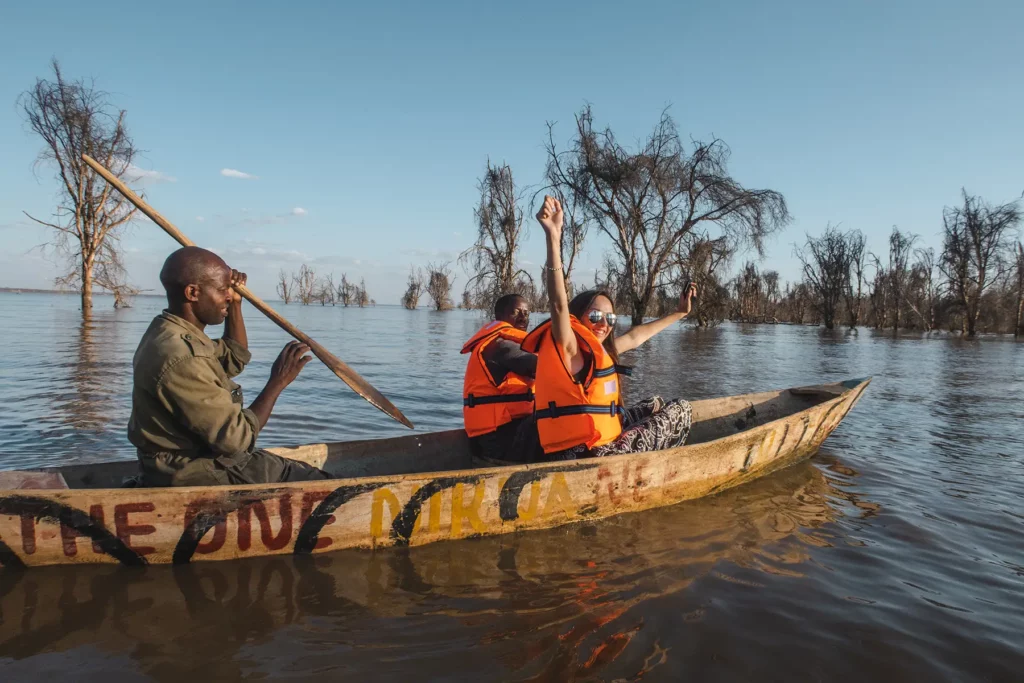
Whilst once Lake Manyara was teeming with life, recent flooding has forced many of the park’s residents, including elephants, lions and flamingos to flee. Therefore epic wildlife sightings are no longer guaranteed here and visitors are often left feeling disappointed. For this reason, I’d recommend Arusha National Park over Lake Manyara.
You can watch a video of my experience canoeing on Lake Manyara National Park below.
Best Arusha National Park Safari Itineraries
Arusha National Park’s proximity to Arusha and its international airport makes it the perfect place to start or end a longer safari trip. Since the park can be visited in just a handful of hours, you can easily squeeze it in if you arrive early in the morning or depart late in the evening.
Arusha National Park Day Trip
Arusha National Park is located a short hour-long drive from Arusha, so you can easily get there bright and early in the morning. There are several activities to choose from, but I recommend starting the day with a walking safari where you have a chance of spotting colobus monkeys, warthogs and buffalos.
Then, after a relaxing lunch, it’s time to hop on a 4×4 for a spellbinding game drive. Alternatively, you can go on a canoe safari to admire the wildlife clustered there.
If you are in serious need of some exercise, you can also do a day hike around Mount Meru and visit the Tululusia Waterfall. The great thing about Arusha National Park is that you can shape your day exactly how you want it.
You can also incorporate Arusha National Park into my 3-day, 5-day or 7-10 day Tanzania Itineraries.
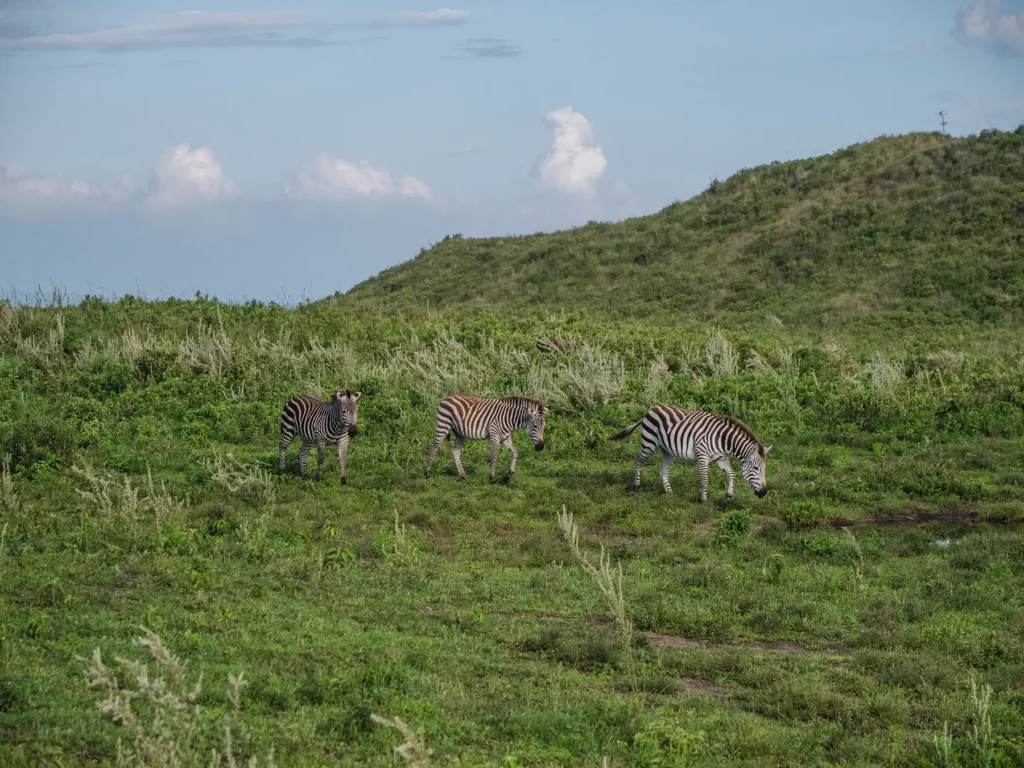
Hiking Mount Meru in Arusha National Park Itinerary
The Mount Meru hike takes 3 to 4 days, with most hikers opting for the four-day route; the latter gives you more time to get acclimated to the altitude… and to ogle at all the animals!
At the start of the hike, you’ll pass through open grassland where you have the chance to see warthogs, buffalo, and more. Once crossing the Ngare Nanyuki River, you’ll begin climbing through the mountain forest which is home to black and white colobus monkeys and many different species of birds. You’ll then spend the night at the Miriakamba Hut.
On the second day, the path leads hikers up through a lush mountain forest (perfect for spotting birds) towards Elephant Ridge, the halfway point of the trail. You’ll then hike up to Saddle Hut where you’ll sleep for a few hours.
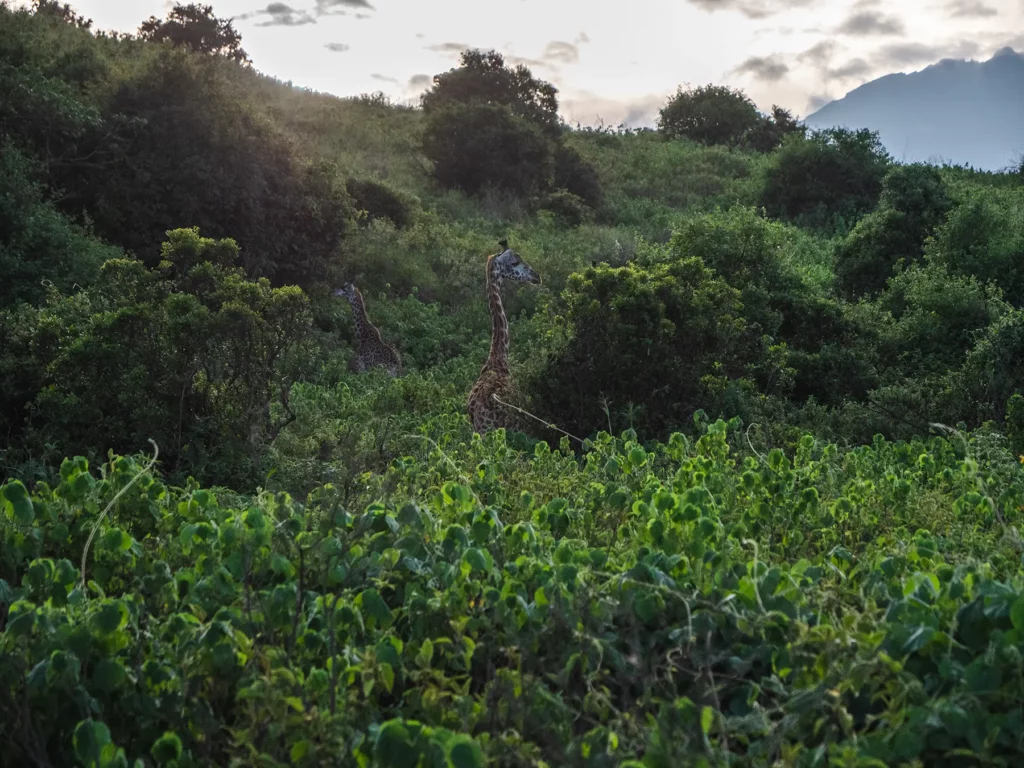
Day three involves waking up at 1 a.m. so it’s no surprise that this is the toughest day with around 10-12 hours of hiking as you push yourself to Mount Meru’s summit. At the top, it’s time for a break and to enjoy your successful ascent. On a clear day, you can get fantastic views of Mount Kilimanjaro and Arusha National Park, after which you’ll descend back to Saddle Hut, where you can have some much-needed relaxation.
On the fourth day, it’s time to head back down to Momela Gate. The hike should only take about 2-5 hours so you still have some time to go on a game drive or a canoe safari if you have any energy left!
During the hike, you can sleep in the series of huts dotted along the trail. This means you don’t have to worry about pitching a tent, and instead can settle in at the end of a long day.
Meru is not a technical climb so anyone reasonably fit should be able to do it with the proper training and preparation. Although it’s possible to climb Mount Meru all year round, you may want to skip it during the rainy seasons (November to December and March to May).
You must hike Mount Meru with a park ranger who can protect you from wildlife like buffalo and leopards. Most hiking trips also include a guide, as well as porters and a chef who will make the hiking trip much more enjoyable.
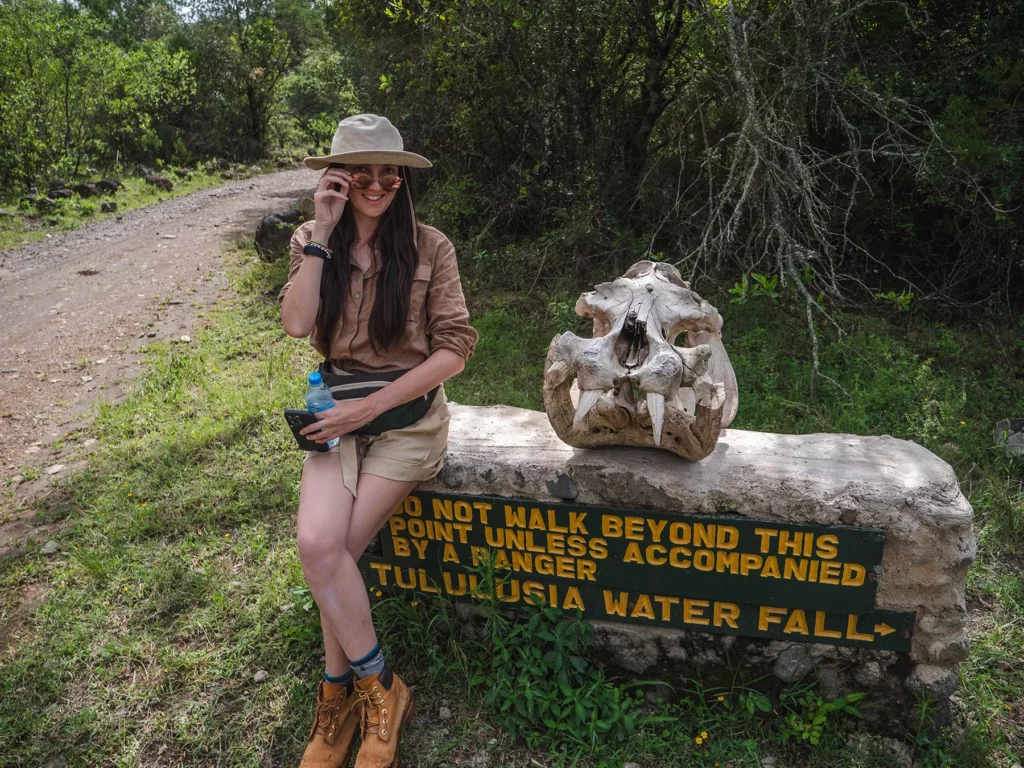
5 Little Known Facts about Arusha National Park
- Arusha National Park is home to the world’s largest population of giraffes.
- Arusha National Park boasts both an extinct volcano and an active volcano.
- Arusha National Park is the closest park to Arusha city, making it perfect for people who are short on time but big on a sense of adventure!
- Mount Meru is one of Africa’s tallest mountains and the second highest peak in Tanzania.
- Arusha National Park has seven shallow alkaline lakes which were formed after the park’s volcano, Mount Meru, erupted thousands of years ago.
Arusha National Park Safari Videos
Recommended Booking Options For Your Arusha National Park Safari Itinerary
Private Safari
Most popular & best experience – typical prices for this itinerary start from $300 per person per day.
Visit safarisbyella.com for free quotes from trustworthy local tour companies I use to book my own trips.

Group (Shared) Safari – Usually Camping
Good for budget or solo travellers – from $220 per person per day.
My recommended Tanzania tour operators only provide private safaris, however, I’ve listed the best and most similar group options for this itinerary, on SafariBookings below.
These group options include Arusha National Park as part of their safari itinerary
Click the link below to request quotes for the group safari options on the SafariBookings website.
1-Day Group Safari to Arusha National Park with Walking Safari
3-Day Group Safari to Arusha National Park, Ngorongoro Crater & Lake Manyara
8-Day Group Budget Camping Safari including Arusha National Park
View All My Recommended Group Options Following a Similar Itinerary
Read More Tanzania Guides
For an overview of planning your safari, you can read my Ultimate Tanzania Safari Guide.
Tanzania Itineraries
Recomended itineraries and how to book them.
7-10 Day Tanzania Safari Itinerary & Costs
5-Day Tanzania Safari Itineraries & Costs (6 unique Itineraries)
3-Day Tanzania Safari Itinerary & Costs
2-Week Tanzania & Zanzibar Safari Itinerary & Costs
3-Week Tanzania Safari Itinerary & Costs
10-Day Tanzania Honeymoon Itinerary & Costs
Tanzania and Kenya Itineraries
Multi-country itineraries and how to book them.
10-Day Kenya and Tanzania Safari Itinerary
2-Week Kenya & Tanzania Safari Itinerary
Costs & Planning
How to get the most bang for your buck and the best time of year to visit depending on what you want to do and see.
Tanzania Safari Cost – Everything You Need to Know!
The Great Wildebeest Migration Guide
Zanzibar Island – The Complete Guide
National Parks & Reserves
Complete guides to the best and most famous safari reserves, including the wildlife you’ll see, entrance costs and best time to visit.
Other Popular Safari Destinations
How to Book Your Safari
Save time and ensure an incredible safari experience by getting quotes from my recommended local safari companies.
Join the rapidly growing tribe of over 1,000 travellers who’ve booked their dream safari using my insider tips and recommendations.

